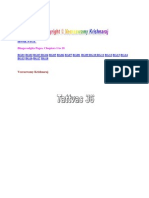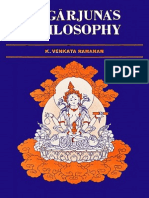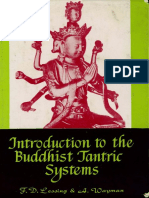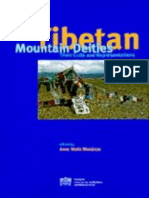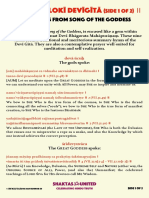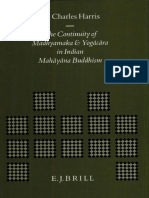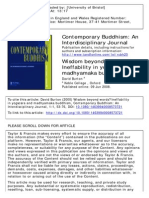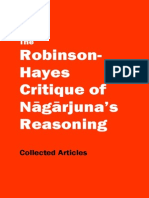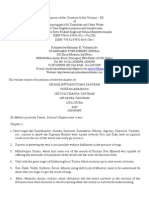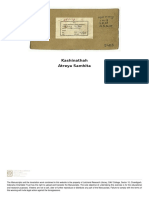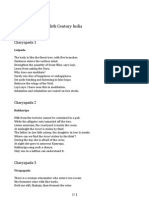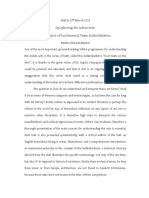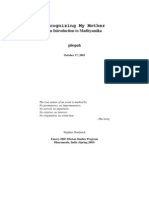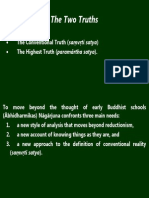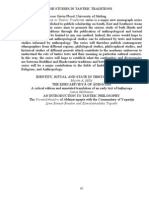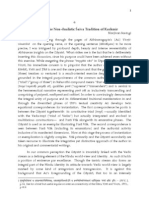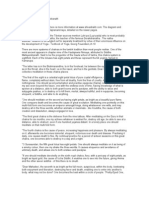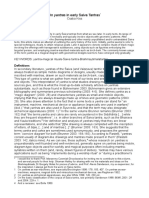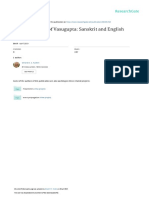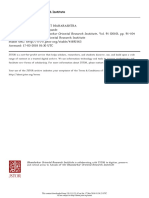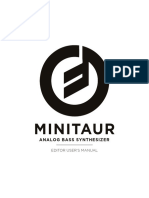Professional Documents
Culture Documents
Flood Review. Worshipping S Iva in Medieval India. Ritual in An Oscillating Universe
Uploaded by
vkasOriginal Title
Copyright
Available Formats
Share this document
Did you find this document useful?
Is this content inappropriate?
Report this DocumentCopyright:
Available Formats
Flood Review. Worshipping S Iva in Medieval India. Ritual in An Oscillating Universe
Uploaded by
vkasCopyright:
Available Formats
BOOK REVIEWS
Schmitt Ru diger, The Old Persian Inscriptions of Naqsh-i Rustam
and Persepolis [Corpus Inscriptionum Iranicarum. Part I Inscrip-
tions of Ancient Iran. Vol. I The Old Persian Inscriptions. Texts
II]. London: School of Oriental and African Studies 2000, pp. 122,
plates 68. ISBN 0-7286-0314-4.
This volume has been published as part of the well-known long-term
series entitled Corpus Inscriptionum Iranicarum, the purpose of
which is to collect and edit all written Old Iranian documents. The
content of this part encompasses approximately 30 Old Persian
inscriptions from the Darius-tomb at Naqsh-i Rustam and from
Persepolis. Schmitt follows the good practice of including translitera-
tion, transcription and translation. Notes and commentaries comple-
ment this work. Plates mostly well-known from the secondary
literature and some from the CII-archive are included for reference.
Despite the critical comments to follow this work is a useful step for-
ward and a helpful tool in the discipline of Indo-Iranian studies. It
dedicates considerable space to the discussion of linguistic problems.
The presently extisting corpus of the Achaemenid Cuneiform
inscriptions is rather limited. However, due to the exclusively writ-
ten tradition of this language, which is often only fragmentary, the
texts must be reconstructed in many cases. Fortunately the majority
of the texts treated in this volume have suered less damage than
the Susa or the Bisutun inscriptions. The contents do not pose
much diculty for reading and interpretation. The only major
damage making understanding somewhat dicult appears in the
Darius inscription of Naqsh-i Rustam (DNb). With the discovery
of a stone tablet XPl
a
near Persepolis in 1967 new impulses stimu-
lated the reinterpretation of DNb.
A few remarks on the mentioned inscriptions may be allowed.
Thereby I apply the established transcription used by Kent, Hinz
and Mayrhofer, slightly modied by K. Homann who adds a dot
Indo-Iranian Journal 48: 133166, 2005.
_C
Springer 2006
DOI: 10.1007/s10783-005-8885-6
underneath the a where it is necessary to indicate the presence of a
schwa (a
) or in the case of a
r to specify the result of the develop-
ment of old r
. Whatever it may have been at the time when these
inscriptions were written, it is certain that it was not r
anymore but
had developed into the sequence vowel+r where the vowel preced-
ing r seems to be phonetically identical with the a
in cases like
aha
y aay aa, etc.
1
While Schmitt speaks of Phonemic/Phonetic Tran-
scription and even writes i
a
and u
a
, he inconsequently does not
mark the schwa. In the transcription, one would certainly expect to
nd pa
rtanay aa, aha
y aay aa, xs aaya#iyaha
y aa, daha
y aaus and the like, but
only nds pr
:
tanay aa, ahy aay aa, xs aaya#iyahy aa, dahy aau
a
s instead.
According to these principles and for the sake of comparability I
have converted the examples discussed here from Schmitts tran-
scription into the more widely accepted transcription.
XPI5f. was not presented correctly by Schmitt. The reviewer has
repeatedly examined this inscription during the last 25 years. The
correct readings and restitutions were subsequently presented, and
in 1998 they were incorporated in the reviewers detailed edition on
the Old Persian inscriptions,
2
which was not mentioned in Schmitts
work. They have been elaborated upon more in a paper in memory
of Hartmut Katz.
3
Xerxes writes in XPI5-9: # aati]y : [Xsa]yaa
:
rs aa : [xs] aa
ya#
|
[i]ya:
va
s
|
[n]
aa: A
|
[uramazd aa[h aa .
aarta
|
[m . dau[s[t aa[ . [ah[miy . taya .
r
aa
|
[sta[m .
da
|
ust
aa . ah
|
[miy[
.
|
mi#a . naiy . daus[t[
aa
|
. ah[mi[y; [.[
na
|
[i[
m
|
aa
.
|
k
|
aama . taya . . . ., which I translate: Proclaims Xerxes
the King: By the favour of Ahuramazda I am friend to the A
rta
4
(= I love the A
rta), I am friend of what is right, I am not friend to
falsehood/injustice. It is not my desire. . ..
1
see Karl Homann: Zur altpersischen Schrift. in: Aufsaatze zur Indoiranistik.
Bd. 2. Wiesbaden 1976. pp.62045.
2
Gu nter Schweiger: Kritische Neuedition der achaemenidischen Keilinschriften.
2 vols. Taimering 1998.
3
Gu nter Schweiger: Miscellanea lndoiranica, in Fremd und Eigen, Untersuchun-
gen zu Grammatik und Wortschatz des Uralischen und lndogermanischen. in memo-
riam HARTMUT KATZ. Wien 2001, pp. 235f. (written and submitted 1998).
4
daustar- Nomen agentis corresponds to the ACC.SG.NEUT. a
rtam. Apart
from compounds in names this is the only attestation of the a
:
rta in the Old Persian
inscriptions besides its occurrence in XPh.
134 BOOK REVIEWS
Whereas Schmitt follows the rendering of Hinz
5
(who himself was
misled by Kents representation of DNb): # aatiy . Xsayaa
:
rsa .
x` ss aaya#iya . vasn aa . Auramazd aah aa . adam . av aakaram . ahmiy .
taya . r aastam . da
|
ust aa . ahmiy . mi#a . naiy . daust aa . ahmiy . naim aa .
k aama . taya . . . ., and he then necessarily follows Kents translation
of DNb: Proclaims Xerxes the King: By the favour of Ahuramazda
I am of such a kind that I am friendly to the to right, (but) I am not
friendly to wrong. It is not my desire . . ..
DNb 13f. yacimaiy pa
rtanay aa bavatiy da
rsam d aaray aamiy mana-
h aa and XP115f. yacamaiy pa
rtan aay aa bavatiy da
rsam d aaray aamiy
manaha
y aa . There is no need to assume exclusively defective writing
in yacamaiy (XPI). While yac]imaiy (DNb) means even if (to) me
deriving from ya ciy -maiy; yacamaiy (XPI) expresses and if
(to) me (< yad ca). Of course the possibility of defective writing
remains as an alternative interpretation.
Schmitt sees in pa
rtanay aa and pa
rtan aay aa the LOC of a neutral a-
stem and the LOC of a feminin aa-stem respectively. Again following
Hinz
6
and rejecting the suggestion of Klingenschmitt
7
for
pa
rtan
`
a ay aa- belligerency because of the lack of a resumptive pro-
noun in the main clause (Schmitt p. 41) he translates: Whatever
occurs to me in a quarrel, I rmly hold back in my thinking.
According to Klingenschmitts proposition this clause must be
translated: When belligerence tempts me, I suppress (it) rmly by
means of my mental power.
8
Schmitts argument against Klin-
genschmitts view does not hold up, since it is not too far-fetched
to assume the ellipsis of an anaphoric pronoun. In many languages,
the ellipsis of anaphorical pronouns does not pose any problem
because comprehension derives from the context. This is also the case
with most of the Old-Indoeuropean languages, as we see in all likeli-
hood in DNb 24f. martiya taya kunautiy yadiv aa anuv tauman ` ssaiy
xsnuta bav aamiy . . .What a man does or brings according to his ability -
(therewith) I become satised . . .. XPl26 f. reads: . . . anuv tauma
avanasaiy xsnuta bav aamiy . . .. . .according to his abilityby this of him
5
Walther Hinz: Altiranische Funde und Forschungen. Berlin 1969. p.46
6
Hinz: loc.cit.
7
Gert Klingenschmitt: Das altarmenische Verbum. Wiesbaden 1982. p.90.
Klingenschmitt had already made this suggestion at earlier occasions.
8
This interpretation is further supported by the Akkadian version of DNb, its
translation being given by the Chicago Assyrian Dictionary as: . . . and even when
I have become angry, (lit.:) I keep it in me (emphasize by the reviewer).
135 BOOK REVIEWS
I become satised. . .. In DNb 26 Schmitt has without stringent justi-
cation emended the phrase to . . . anuv taumansaiy < avan aa >
xsnuta ba aamig . . . and thereby has not taken into consideration the
possible ellipsis of this pronoun.
It is indeed dicult for all of us to nd, read and to integrate all
the secondary literature on a subject. Schmitt is not exempted
either, as a few examples demonstrate.
- When dealing with XPm he writes: Mayrhofer 1978, 20 [wrongly
seen in relation to XPj], and does not mention that it was Mayer-
hofer himself who suggested it be labelled XPm. And Schmitt fur-
ther writes: So far no photograph of any of these fragments has
been published. . .. But there is at least one publication showing a
photograph of one column base found by Akbar Tadjvidi.
9
This
photograph is reproduced in the reviewers edition.
10
- On p.36 Schmitt writes in the note for DNb 30f.:
s-p-a-
y-t
|
-i-
y-a
|
- v -y-a here according to the photographs avail-
able and following s-p-a-y-t-i-y-y-a XP134f. (cf. Schmitt 1997,
272f.), . . .. This particular word has been read and corrected
independently and at the same time by Gershevitch
11
and the
reviewer in 1979.
12
- Dealing with A
3
Pb Schmitt writes p. 119: . . . the symbol A
3
Pb has been preferred here to the unsatisfactory A?P
. In this
context, one cannot disregard Krefter
13
, who initiated and justi-
ed this association to Artaxerxes III. The arguments for label-
ling A
3
Pb and literature are given in the reviewers
comprehensive edition (not included in Schmitts list of secondary
literature).
9
apud Al Saam: P aaitaxth aa-ye
`
SSahans aahan-e Hax aamanis. (
`
SS uu`ss - Hagmataaneh
- Taxt-e-Jam`ssd).
`
SSiraaz, Deymaah 1348 Hj. (= Jan.1969). Photograph of XPm on
p. 235. Finding and reading such literature would however require good knowl-
edge of New Persian (Faars).
10
Schweiger: op.cit., p. 145.
11
Iliya Gershevitch: No Old Persian spa#maida. apud FsSzemeerenyi Teil I,
1979,291295.
12
Gu nter Schweiger: Sprachlicher Vergleich der lnschriften DNb und XPI.
Paper delivered at the Philosophical Faculty IV of the University of Regensburg
in 1979.
13
Friedrich Krefter: Achamenidische Palast- und Grabturen. in: Archa ologische
Mitteilungen aus Iran. Neue Folge (Berlin), vol.1, 1968, pp. 99113.
136 BOOK REVIEWS
A word to the labelling of inscriptions: well established sigla
should not be relabelled for lack of good reason, since confusion
may easily result (Examples XPn, XPo, XPq, XPr, or DPb
H
, the
later of which was renamed DPj).
A few minor points deserve perhaps to be mentioned, i.e.
- Unfortunately the transcription does not indicate which parts of
an inscription are preserved and which have been restituted, nor
does it indicate which words are emended. Emendations like the
above mentioned avan aa (DNb 26) are prematurely inserted in the
transliteration and it is only there that they are marked as such.
Because of this drawback the reader of the transcription is not
aware of these circumstances and has to turn to the pages of the
transliteration, to uncover the original state.
- We nd notes that are unnecessary or even wrong like p. 101,
where Schmitts note to XPl52 reads: b-b-t-n-i-y XPl
a
(not
noticed by Hinz 1969, 46b), to be corrected in accordance with
DNb 47 b-r-. . . . . .. In reality, Hinz had very well observed this
fact in the said publication a few pages later.
14
Here Hinz
remarks simply: In Zeile 52 hat das r in brtanaiy einen waage-
rechten Keil in der Mitte zu wenig. This is short and to the
point, since it is obvious that b-r-. . . was meant.
The scholar would certainly like to see more critical annotations
and discussion on the possible readings of the destroyed characters,
which would enable him to make his own evaluations and to take
part in the adventure of the quest for the original text. Despite
these minor points, the book is linguistically enriching and well
worth the scholarly attention it demands.
GU
NTER SCHWEIGER
Bahnweg 9
D - 93104 Taimering
14
Hinz: op.cit., p. 51 b.
137 BOOK REVIEWS
Cardona, George and Dhanesh Jain [Eds.], The Indo-Aryan Lan-
guages. [Routledge Language Family Series]. London: Routledge,
2003, pp. XIX, 1061. 5 maps, 7 gures. ISBN 0-7007-1130-9.
165,-.
This monumental volume intends to provide a language-family
descriptive book replacing earlier works such as G. A. Griersons
Linguistic Survey of India published between 1903 and 1928,
J. Blochs Lindo-aryen du veda au temps modernes (1934, Eng-
lish 1965) or the brief, but well informed survey by G. A. Zograf
Jazyki Ju`zznoj Azii. Moscow 1990, which is not mentioned.
Moreover, it supplements the earlier volume on Indian languages in
the same series, The Dravidian Languages edited by Sanford
B. Steever and published in 1998.
The overall plan of this carefully conceived book is outlined in
detail in the introduction, where also those topics are mentioned,
which could not be included, because no competent or willing con-
tributor could be found in spite of continuous eorts by the edi-
tors. Thus, there is no chapter on Marwari, and none on the
typology of the Indo-Aryan languages. Consequently features such
as the Dardic metathesis (Mittelindisch
1
19, 93) are nowhere
mentioned. Moreover, Indo-Aryan languages outside India are not
included, which are surveyed, e.g., by Hans Henrich Hock in his
article Out of India? The linguistic evidence.
2
There is a brief
remark on Bangani (p. 25) pointing out the unfortunate contro-
versy, which has spoiled this potentially highly interesting mate-
ria1.
3
Before the individual languages are described, the general intro-
duction by G. Cardona and a chapter on the sociolinguistics by
1
O. v. Hinu ber: Das a ltere Mittelindisch im U
berblick. O
sterreichische Akade-
mie der Wissenschaften. Philosophisch-historische Klasse. Sitzungsberichte, 467.
Band. Vero entlichungen der Kommission fu r Sprachen und Kulturen Su dasiens,
Heft 20. Wien
2
2001.
2
In Johannes Bronkhorst and Madhav M. Deshpande [Eds.], Aryan and Non-
Aryan in South Asia. Evidence, Interpretation and Ideology [Harvard Oriental
Series Opera Minora, Vol. 3]. Cambridge, MA, 1999.
3
Perhaps all parties involved should bury their animosity for a while and clarify
the issue by joint eld research, which seems to be the only way to save this
important material from eternal unusibility.
138 BOOK REVIEWS
D. Jain introduce the reader to the subject. A chapter on script
(R. Salomon) outlines the general palaeographic developments,
while the scripts of the individual languages are treated in the
respective chapters.
The languages are described and arranged according to their
importance in present day India taking typological features into
account as well. The historical background is provided by three
chapters on Sanskrit (G. Cardona), As okan Prakrit and Pali (Th.
Oberlies), Prakrits and Apabhras a (V. Bubenik). Unsurprisingly,
Sanskrit is decribed from the view point of a Pa
ninya in a
superb piece of scholarship. The setback, however, is a conscious
omission (p. 106) of Sanskrit varieties such as epic or Puran
:
ic,
even in the bibliography in the section further reading found
at the end of all chapters. The Grammar of Epic Sanskrit by
Th. Oberlies appeared simultaneous with the book (Berlin 2003),
but, e.g., R. Salomon, The Vis
:
n
:
u Puran
:
a as a specimen of ver-
nacular Sanskrit, WZKS 30. 1986, pp. 3956 might have been
mentioned. Furthermore, colloquial Sanskrit did not nd any
attention, cf. again R. Salomon, The Ukti-vyakti-prakaran
:
a as a
manual of spoken Sanskrit, IIJ 24. 1983, pp. 1325 or M. Desh-
pande, On Vernacular Sanskrit: The Grva
nava
nman jar of
Dhu
:
n
:
diraja Kavi.
4
Although Buddhists and Jains are mentioned
as writers of texts in Sanskrit (p. 106) one might add Mus-
lims
5
, the peculiar variety used in both these religious literatures
is not described.
In the paragraph on further reading on Sanskrit the reader is
surprised by a reference to R. Hauschild Register zur Altindischen
Grammatik. Most likely, only a limited number of students will
read this extremely useful index from cover to cover without getting
slightly bored before nally reaching the last entry -hvti- a 206,
aa 113; e 633.
Needless to say that these are minor points, which might have
been taken into consideration. However, any reader is richly
4
In M. M. Deshpande, Sanskrit and Prakrit. Sociolinguistic Issues. Delhi 1993,
3351. Sanskrit as spoken today is investigated, e.g., by R. N. Aralikatti, Spoken
Sanskrit in India. A Study of Sentence Patterns. Tirupati 1989.
5
Cf. Jatindra Bimal Chaudhuri: Contributions of Muslims to Sanskrit Learn-
ing. Calcutta. Vol. II. Khan Khanan Abdur Rahim 1954; Vol. III (Muslim
Patronage to Sanskrit Learning) Works of Rudrakavi: Khan-Khanan-Carita;
Dana-Saha-Carita, Khurm-Carita. 1959. Vol. I is not accessible to me.
139 BOOK REVIEWS
rewarded by the learning of the author and by his discussions of
numerous aspects of Sanskrit among them the Middle Indic
forms found in Sanskrit grammarians such as aan
:
apayati,
a technical term of the Maurya administration (As oka: deva-
na
:
mpiye aanapayati, cf. Mittelindisch 241), which survived in
Satavahana inscriptions, e.g., in Nasik (Gotamiputo . . . aanapayati,
EI 8. 1905/06, 73 line 2) and found its way even further south
to the Pallavas (Sivakha
:
mdavammo . . . aanapayati, EI 6. 1900/
01, 86 line 4 = T. V. Mahalingam: Inscriptions of the Pallavas.
Delhi 1988, no. 2) before it was replaced by a dierent formular
(Na
:
mdiva
:
mmassa vacan
:
ena . . . bh aan
:
itavv aa, EI 31. 1955/6, 5
line 6).
The chapter on Prakrit is marked some strange blind spots.
Gandhar is not mentioned at all, though it gures briey in
R. Salomons chapter on script, nor are Prakrit inscriptions
referred to except in the (wrong) statement (p. 212) that R. Pi-
schel did not include them in his Prakrit Grammar. He did:
Inscriptions known during his time were duly noted, cf. Pischel
8. It is also a bit astonishing that the author still follows A. Gri-
erson and locates Paisac in the Northwest(!) (p. 208).
6
And it
is equally puzzling that no mention is made in the bibliography
to the important works by C. Caillat particularly on the lan-
guage of the Jains nor to, e. g., G. H. Schokkers important
article The Prakrits of the Drama: Their Literary Function as
Illustrated by the Karp uuraman jar,
7
or others. On the other
hand, the really outdated investigation by Hia nlin Dschi (Ji
Xian-lin, quoted as Hia n-lin, D.!) on the endings -a
:
m / -o / -u
in Buddhist Sanskrit has been retained. F. Edgertons Buddhist
Hybrid Sanskrit is, however, missing.
The description of modem languages begins with one of the
outstanding contributions dealing with Hindi (M. C. Shapiro),
although one misses here as almost everywhere any reference to
the rich Russian researches on modern Indo-Aryan languages,
the only exception being as a matter of course E. Bashir in
here very detailed and comprehensive treatment of the Dardic
languages.
6
On the possible origin of Paisac cf. Mittelindisch 98102.
7
Sambodhi 5, No. 23, 1976, S. 148165.
140 BOOK REVIEWS
While the articles on Hindi and Urdu (R. L. Schmidt), the
latter being twice as long as the description of Hindi, pay due
attention also to the historical background of both languages,
this is almost completely missing in other contributions such as
the one on Marathi (R. Pandharipande), although traces of this
language are rooted far back in the past. As V. V. Mirashi noted,
8
the Basim copper plates of the Vakat
:
aka ruler Vindhyas akti II (mid
4th century) attest the old Marathi gen. ending in -si(
:
m) in names
such as Ven
:
hujjesi : Vis
:
n
:
varyasya, a fact that seems to have been
overlooked in descriptions of the history of Marathi.
In addition, the book contains surveys of the following lan-
guages: Bangla (P. Dasgupta), Asamiya (G. C. Goswami; J.
Tamuli); Oriya (T. R. Ray); Maithili (R. Yadav); Magahi
(S.Verma); Bhojpuri ( M. K. Verma); Nepali (T. Riccardi); Pan-
jabi (C. Shackle); Sindhi (L. M. Kubchandani); Gujarati (G.
Cardona; B. Suthar); Konkani (R. V. Miranda); Sinhala (J. W.
Gair); Kashmiri (O. N. Koul). The Sinhala part, which also
refers to Dvivehi, is now to be supplemented by Sonja Fritz,
The Dvivehi Language. A Descriptive Historical Grammar of
Maldivian and Its Dialects. Wu rzburg 2002. Thus the book cov-
ers some languages not dealt with in the Russian series Jazyki
Narodov Azii i Afriki, which, however, comprises in addition a
volume by T. V. Ventce1, Cyganskij jazyk. Moscow 1964 and
by Ju. A. Smirnov, Jazyk Lendi. Moscow 1970.
This comprehensive and impressive handbook on the modern
Indo-Aryan languages oers a wealth of information, which will
become really evident only after using the book over a longer per-
iod. In praising editors and contributors for their achievements,
one should not forget those anonymous members of Ratna Sagar
in Delhi, who had the nightmarish task of providing indices, which
they did with care and circumspection. Thus, this is really a volume
that must nd its place on the desk of all studying the Indo-Aryan
languages in spite of the exorbitant price: An aordable paperback
edition is urgently called for.
O. v. HINU
BER Kartauserstrasse 138
D-79102 Freiburg i. Brsg.
Deutschland
8
V. V. Mirashi, Inscriptions of the Vakat
:
akas. CII V. Ootacamund 1963, p. 94.
141 BOOK REVIEWS
Jayawardena-Moser, Premalatha, Grundwortschatz Singhalesisch-
Deutsch mit grammatischer
UUbersicht. 3., uuberarbeitete Auage. Wies-
baden: Harrassowitz Verlag 2004, pp. XIV, 216. ISBN 3-447-
05027-6. C
=
34,-.
Nachdem sich die Verf.in bereits mit der vierten Auage des
Singhalesischlehrbuches von K. Matzel um die Verbreitung der
Hauptsprache Ceylons verdient gemacht hat, (IIJ 47. 2004, pp.
63f.), legt sie nun ein auf die praktischen Bedu rfnisse auch eines
Selbststudiums zugeschnittenes Hilfsmittel vor. Das Werk, dessen
Nutzen durch die Zahl der Auagen dokumentiert wird, hat sich
zum Ziel gesetzt, einen auf der Grundlage von Statistiken ermittel-
ten Wortschatz von 2530 Wo rtern zu sammeln, mit dessen Hilfe
die Lektu re von Zeitung oder Kurzgeschichte gelingt. Dem eigentli-
chen Wo rterverzeichnis geht eine Schriftlehre und ein knapper gram-
matischer Abriss voran. Das ganz besonders durch die glu cklich
gewa hlte singhalesische Type selbst fu r einen der Schrift noch
wenig kundigen Anfa nger gut lesbare Buch wird von jedem am
Singhalesischen Interessierten auch in der neuen Gestalt dankbar
genutzt werden und bietet durch die Erarbeitung des Grundworts-
chatzes des Singhalesischen selbst der Wissenschaft ein nu tzliches
Hilfsmittel.
O. v. HINU
BER Kartauserstrasse 138
D-79102 Freiburg i. Brsg.
Deutschland
Davis, Richard H., Worshipping S
iva in Medieval India. Ritual in an
Oscillating Universe. Delhi: Motilal Banarsidass 2000, pp. xvi, 200.
ISBN 81-208-1747-8. Rs 295, -.
Rodrigues, Hillary Peter, Ritual Worship of the Great Goddess. The
liturgy of the Durga Puja with interpretations. Albany: State University of
New York Press 2003, pp. xvi, 417, 25 gures. ISNB 0-7914-5399-5
(paperback: ISBN 0-7914-5400-2-5). $ 71,50 (23,95).
142 BOOK REVIEWS
The publication of Hele`ne Brunner-Lachauxs edition and translation,
over the years, of the Somasambhu-paddhati has been a milestone in the
academic study of tantric or agamic ritual. That work has begun to impact
upon the Anglophone world. The two books under review are further
contributions to this understanding.
Richard Davis book is a reprint of the 1991 Princeton University Press
publication under the reverse title of Ritual in an Oscillating Universe:
Worshipping S
iva in Medieval India. In this book Davis provides an
excellent account of S
aiva Siddhanta theology and how it articulates with
S
aiva ritual, thereby arguing for a link between knowledge ( jnana) and
ritual action (kriya) in the tradition: that S
aiva Siddhanta ritual is per-
vaded by theology and cannot be understood without it. He mainly draws
on two texts, the Kamikagama and Aghorasivas Kriyakramadyotika,
but accompanied by eldwork and a particularly helpful and knowledge-
able informant, S
r K.A. Sabharatna Sivacarya of Madras (who has, if
I am not mistaken, appeared as a younger man in Brunner-Lachauxs
earlier volumes of the Somasambhu-paddhati). The introduction locates
the S
aiva Siddhanta in the context of Cola history and the construction of
the magnicent temples of Tamilnadu and provides an introduction to
S
aiva Siddhanta as a system. The rst chapter, Ritual and Human
Powers, describes the fundamental S
aiva categories of the Lord ( pati),
bound souls ( pasu) and fetters ( pasa) and how the bound soul becomes
free from its fetters through daily S
aiva worship. Chapter two offers an
account of cosmology and the oscillating universe, describing cosmic
emanation and reabsorption of the categories or tattvas, pointing out some
similarity and difference with Advaita Vedanta and Kashmir S
aivism, and
showing how this oscillating pattern maps on to the body through the use
of mantras. Davis gives a good account of the purication of the body in
the bhutasuddhi and the reconstitution of a puried, divine body through
imposing mantras upon it. The book is one of the few English publi-
cations to present these details. The third chapter discusses becoming a
S
iva, showing how in S
aiva Siddhanta theology the soul is ontologically
distinct from the Lord S
iva and remains so even in liberation. The text
discusses how liberation is brought about through initiation and, using the
Kamikagama, recapitulates Hele`ne Brunners general account of different
types of initiation. Chapter four describes summoning the Lord in
different forms, particularly as he is invoked in the li
nga, in mantras, and
in the body of the practitioner. Next we have an interesting discussion of
relations of worship in puja and how the worshipper, the offerings, and
S
iva, express the relationships between the three categories of being. A
143 BOOK REVIEWS
short conclusion reiterates how knowledge of S
iva is embedded within
ritual action. While the book does not go much beyond Brunner
Lachauxs account of S
aiva Siddhanta ritual, it is nevertheless a well
researched, good, solid book that makes available, in some textual detail
for a wider audience, the complexity of S
aiva Siddhanta theology and
ritual. The book is clearly written and is convincing in showing how the
propositional discourse of philosophical knowledge and the practical
discourse of ritual action are integral to each other (p. ix).
While Davis book is principally an account of S
aiva Siddhanta
theology and ritual as it was practiced in around the ninth to eleventh
centuries, complemented by contemporary eldwork, Rodrigues book is
principally an account of the Durga Puja as practiced today, comple-
mented by textual study. The book was Rodrigues Ph.D. dissertation
which he has transformed into an interesting and clearly written book.
The book has a fairly narrow focus, the Durga Puja as practised in
Banaras during the ninenight festival (Navaratra) during the Indian lunar
month of A
svina, focussing especially on the Bengali-style puja in the
home of Bengali brahmin family. Part 1, Context and Overview, pro-
vides an account of what the Durga Puja is, who performs it and for
whom. It also gives in summary form a description of the rite which the
book then proceeds to ll out in full detail in Part II, Description of the
Durga Puja. A clay image of the Goddess and with her entourage of
deities is installed in the house to which worship is offered and Rodrigues
takes the reader through each day of the Puja, describing the specic
events that occur, including the sacrice of a goat at the Durga Kal
temple, although such blood offerings are rapidly disappearing, one of
Rodrigues informants describing the rite as a ghastly affair that should
be avoided by substitution (p. 215). Part III, Interpretations, offers
some discussion on the nature of Puja, the nature of the Goddess, and the
social function of the Durga Puja, pointing out, for example, the close
relationship between blood sacrice, connected to fertility and woman-
hood, and virgin worship. What is particularly interesting is the in-
tegration of tantric and vedic ritual, with sometimes vedic mantras
being used and other times tantric mantras. We have here an example of
tantric ritual which has become integrated into a mainstream vedic
tradition. This book is extremely rich in detail and provides a thick
ethnography of the rites.
Both books provide detailed accounts of tantric rites and are ne
contributions to our understanding. Reading both books together, this
reviewer is struck by the parallel ritual processes involved, such as the
144 BOOK REVIEWS
pervasive purication of the elements in the body (bhutasuddhi) and the
divinisation of the body through imposing mantras upon it (nyasa). Yet
one is also struck by the text and tradition specicity of the rites within a
more general, ritual framework. As Davis observes, the actions of ritual
are not personal but traditionally prescribed. Indeed, that the rites are
textually informed is an important observation; the S
aiva agamas and
ritual manuals in one case, the ritual manual called the Purohita Darpana,
in the other. Both books are well illustrated, illustrations which bring to
life the ritual details described. These books are good contributions to our
understanding of what might be called tantric ritual in both its medieval
origin and contemporary expression.
GAVIN FLOOD Department of Religious Studies
University of Stirling
FK9 4LA, Stirling, UK
Vievard, Ludovic, Vacuite (sunyata) et compassion (karu
na) dans le
bouddhisme madhyamaka [Publication de lInstitut de Civilisation
Indienne. Fascicule 70]. Paris: De Boccard 2002, pp. 340. ISBN
2-86803-070-X.
Western scholarship on Madhyamaka has long been focused on the
latters analytical approach to reality or emptiness, while neglecting the
Mahayana context, equally important to it, of a Bodhisattva career, which
requires complementing ones intellectual assessment that everything
lacks an own-being with compassion by giving rise to bodhicitta. In
Vacuite et Compassion Vievard tries to ll this gap by adding to his
presentation of emptiness (chapter 1) an equally long chapter on
compassion. The last third of the book, nally, is devoted to a
demonstration of the compatibility of compassion with emptiness.
Vievards points are well documented by quotations and translations
from a huge range of mainly Indian Mahayana texts. The translations are
examplary and show the philological competence of the author. There
are, however, a few methodological concerns with regard to the selection
and interpretation of the Mahayana material that need to be addressed.
Even though Vievard acknowledges a variety of positions with regard
to the discussed topics, he presents the latter as if there had been one
coherent Madhyamaka school down through the centuries from Nagarjuna
145 BOOK REVIEWS
till Candrak..rti and S
antideva. In his introduction (p. 21) Vievard admits
that he himself follows the Prasa
ngika school of Madhyamaka, even
though a school with such a name never existed in India (the distinction
between Prasa
ngika and Svatantrika being rather Tibetan in origin).
Vievards book reads like a brilliant work by a Buddhist scholastic well
anchored in an Indo-Tibetan tradition. With the imprimatur of the Colle`ge
de France one would expect, however, a study that describes the historical
development of Madhyamaka thought independently of any particular
hermeneutic strategy which discusses away dierences and arranges the
huge corpus of Sutras and S
astras into a consistent whole.
Obviously inuenced by such a traditional hermeneutic approach,
Vievard bases his general statements on the Mahayana or the Madhya-
maka on a wide range of texts, including some of questionable origin,
such as the Bodhicittavivarana. The latter quotes the Guhyasamajatantra
and can thus not be by Nagarjuna, but Vievard (p. 55) uncritically refers
to the Bodhicittavivara
na together with the Mulamadhyamakakarika as
Nagarjunas own view on the necessity of meditation. Equally disturbing
is the fact that Vievard frequently quotes the *Mahaprajnaparamitasastra
whose Sanskrit original is not available (it is not clear whether
Kumarajva was partly its author or only its translator). Thus Vievard
fully endorses this sastras distinction between the S
ravakayana and the
Mahayana in a subchapter called Du bouddhisme ancien au Mahayana
(pp. 316), approving as he does the stance that the S
ravakas only teach a
sattvasunyata, while the followers of the Mahayana also maintain a
dharmasunyata alongside the latter. Vievard then concludes that the
Buddha thought in terms of only one mode of emptiness, which he merely
dierentiated with respect to dierent objects or realms that are empty (p.
35). Such a presentation of emptiness is untenable, however. It is not only
that Abhidharma ontology knows of short-lived dharmas which really exist
in terms of their own-being (svabhavena); but the Yogacaras and
proponents of the Tathagatagarbha, too, had quite dierent ideas on what
emptiness means. Suce it to remark here that the sarvadharmasunyata
and the (sva)lak
sa
nasunyata of the Prajnaparamitasutras (which are
usually interpreted as referring to the lack of an own-being in all phe-
nomena and specically characterized entities) become the emptiness
with respect to all Buddha-properties and the emptiness of major and minor
marks of a Buddha respectively in the Madhyantavibhaga, (see MAV-
tka I.
17-9) since in the latter emptiness equates to the negation of duality of a
perceived object and a perveiving subject, which does not exclude the
existence of mental factors etc. in terms of being svabhava or svalak
sa
na.
In other words, the sarvadharma- and (sva)lak
sa
nasunyata of the
146 BOOK REVIEWS
Prajnaparamitasutras do not really t the Madhyantavibhaga (which is
Yogacara, but still Mahayana) and are thus reinterpreted. Much could be
said about the history and great variety of ideas relating to sunyata in India
(even among the Madhyamikas), and it is amazing how condently
Vievard presents the Mahaprajnaparamitasastras understanding of
emptiness as the doctrine of Madhyamaka, and sometimes even Mahayana
in general.
This leads to another problematic part in Vievards book: the biased
presentation of Yogacara and its hermeneutics. Vievard (p. 745), for ex-
ample, quotes the denition of emptiness in the tattvartha chapter of the
Bodhisattvabhumi and identies without comment vastumatra with the
dependent nature ( paratantrasvabhava), even though the trisvabhava the-
ory plays no role at all in this early Yogacara work (it is only in the later
Vini scayasa
mgraha
n.. portion of the tattvartha chapter that a trisvabhava
theory is formulated, and the attribution of the three natures to the key-
terms of the Bodhisattvabhumi is everything else than clear). In the part of
the tattvartha chapter Vievard refers to, vastumatra is equated with the
inexpressible suchness which lies within the experiential range ( gocara)
of non-conceptual wisdom. If anything, vastumatra should thus be re-
lated with the perfect nature ( parini
spannasvabhava). Still, Vievard con-
cludes that: La chose nue (vastumatra) correspond au referent
objectif. Elle est rien dautre que le paratantra vide de parikalpita,
cest-a-dire le parini
spanna, et donc la sunyata elle-meme (p. 75). To
call the experiential object of wisdom (both of which are beyond the
duality of a perceived and a perceiver) a referent objectif is mislead-
ing, and all the more so since Vievard himself does not accept such
an objective point of reference in the context of Madhyamaka (see
below).
Vie vard further criticizes the Madhyantavibhagas denition of emp-
tiness as the non-existence of duality and lexistence reelle (sadbhava)
de cette inexistence (p. 75). Neither in the Madhyantavibhaga (MAV)
nor in its commentaries by Vasubandhu and Sthiramati (see the bha
sya
and
tika on I.13) is such a sadbhava of the non-existence of duality
found. Only the term bhava (Tib. dngos po) is used, which is equated
with svabhava by Vasubandhu (Nagao (ed.): MAVbha
sya, Tokyo: Suzuki
Research Foundation, 1964, 22, l. 24 23, l. 1: tasya cabhavasya
bhava
h sunyataya lak
sa
nam ity abhavasvabhavalak
sa
natva
m. . .). Here
it means rather state or own-being of the non-existence of duality.
Of this own-being it is then said in MAV I.13c (in bold letters) that
neither existence nor non-existence apply to it (MAVbha
sya, 23, 11. 23:
tad(=dvaya)abhavasvabhava
h sa na bhavo napi cabhava
h).
147 BOOK REVIEWS
Vievard then adduces Mulamadhyamakakarika (MMK) XIII.7 (If s.th.
non-empty existed, there would be s.th. empty. Since there is no such
thing which is not empty, where can the empty then be?) in order to
show that the Madhyamikas do not agree with such a denition of
emptiness, namely, that s.th. empty exists. Based on this Vievard infers
that emptiness is only a linguistic element which eliminates the possibility
of attributing any predicate to anything (pp. 756). As such emptiness
even does not exist without a sage (p. 255: Puisquil ny a point de
compassion sans compatissant (karu
nika), ni de vacuite sans sage
( prajna), il est indispensable de proposer une approche anthropo-
logique). In other words, Madhyamakas emptiness is interpreted as
a meta-linguistic enterprise, in which emptiness has no referant
objective; it should not, therefore, be confounded with ultimate truth
and the like.
In my opinion, MMK XIII.7 in no way proves that emptiness cannot be
taken as the ultimate. Moreover, I do not see that much of a contradition
between it and the Madhyantavibhaga, except, of course, that the
negandum in the MAV is duality, and in the MMK an independent
own-being (svabhava) of phenomena. For Candrakrti (who is considered
to be authoritative for a Prasa
ngika interpretation of the MMK), verse
XIII.7 shows that emptiness itself does not exist, because one realizes
here that emptiness is the general characteristic of all phenomena,
wherefore phenomena which are not empty do not exist. (La Vallee
Poussin (ed.): Mulamadhyamakakarikas (Bibliotheca Buddhica 4), Delhi:
Motilal, 1992, 246, ll. 13: iha hi sunyata nameti sarvadharma
na
m
samanyalak
sa
nam ity abhyupagamad asunyadharmabhavad sunyataiva
nasti / ), and emptiness is also taken as a samanyalak
sa
na in MAVbha
sya
I.13 (Nagao 1964:23, l. 10). A careful study of Candrakrtis Prasanna-
pada on MMK XV.2cd also shows that emptiness which is equated,
among other things, with the dharmata, svarupa, and svabhava of
phenomena (La Vallee Poussin (ed.) 1992:264, ll. 11ff.) can be the
experiential object of the Noble Ones: Entities which have come under
the inuence of the eye disease [known as] ignorance in which form
they attain, through the practice of not seeing [them], to the state of being
the object of the Noble Ones, whose eye disease, ignorance, has
been removed precisely this [form] is their own-being, their essential
nature. . . . (La Vallee Poussin (ed.) 1992:265, ll. 35: avidyatimirapra-
bhavopalabdha
m bhavajata
m yenatmana vigatavidyatimira
nam arya
nam
adarsanayogena vi
sayatvam upayati tad eva svarupam e
sa
m svabhava iti).
This practice of not seeing describes in a similar way how suchness
(equated with emptiness) is the experiential object of wisdom in the
148 BOOK REVIEWS
Madhyantavibhaga. Suchness and wisdom, that is, should not be
misunderstood as a perceived object and a perceiving subject. Since
Vievard accepts the Bodhicittavivara
na as being by Nagarjuna, I may also
refer to verse 57 of the latter which says: I claim that the nature of all
phenomena is emptiness, in the same way as sweetness is the nature of
sugar and hotness that of re. (Cf. Lindtner: Nagarjuniana, Delhi: Motilal
1987, 2023).
Further MMK XXIV.18 (ya
h pratityasamutpada
h sunyata
m ta
m
pracak
smahe / sa (or: sa) prajnaptir upadaya pratipat saiva madhyama)
is adduced in order to show that emptiness is a metaphorical designation.
Vievard (p. 78) takes the verse to be ambiguous but follows de Jong (who
translates the third pada as: La vacuite est la designation metaphorique,
Vievard (p. 79)) without even discussing Nagaos (From Madhyamika to
Yogacara: An Analysis of MMK, XXIV.18 and MV, I.12, Madhyamika
and Yogacara, Albany: SUNY, 1991, 18999) convincing arguments, such
as that once dependent arising is ascertained as being emptiness by an
enlightened mind, the phenomenal world of ordinary life is then under-
stood as a designation based on some material. To be sure, I do not
attempt to outright deny that there are strands in the Madhyamaka litera-
ture which support Vievards interesting interpretation, but those who
study the latters book should remember that they read only one particular
understanding of Madhyamaka that disapproves of other equally impor-
tant aspects.
Finally, the question of hermeneutics needs to be addressed. When
presenting Madhyamaka as an independent Mahayana school in all its
aspects, as the present study under review tries to do, one faces the
problem that the analytical works of Nagarjuna etc. lack a detailed pre-
sentation of common Mahayana elements such as the path, compassion,
and bodhicitta. Tradition thus attributed a number of texts to Nagarjuna
(the Dharmadhatustotra or the Bodhicittavivara
na, for example) in order
to have authoritative Madhyamaka works to refer to which explain the
ten Bodhisattva-levels or bodhicitta. In this respect, it is also of interest
that the Sutrasamuccaya (also said to be by Nagarjuna) quotes and
discusses certain Mahayana sutras which restrict the dictum that all
phenomena lack an own-being (i.e., their emptiness) to the level of the
phenenomenal world (S
r..maladev..sutra) or the imagined nature
(La
nkavatarasutra). In order to show that there is ultimately only one
single yana, the compilers of the Sutrasamuccaya (Pasadika: Nagarjunas
Sutrasamuccaya, Copenhagen: Akademisk Forlag i Kommission, 1989,
12930) even quote from the Dhara
n..svararajasutra the example of
the threefold purication of a vai
durya stone, which illustrates the
149 BOOK REVIEWS
successive teachings of the three dharmacakras. This implies that the
second dharmacakra, which teaches the emptiness of the Prajnaparami-
tasutras, is outshone by a nal dharmacakra that describes the ultimate in
positive terms. A work of Vievards scope should have addressed these
facts and discussed how some Madhyamikas could pick certain passages
from the above-mentioned sutras without being forced to endorse, for
example, the entire S
r. maladev.sutra literally, and thus claim that the
Buddha-nature (equated with the ultimate by the Anunatvapur
natvanir-
desaparivarta) is empty of all delements which are separable, but not
empty of the inseparable Buddha-qualities. In view of this, Vievard (pp.
735) should have been more careful not simply to disqualify the
Sa
mdhinirmocanasutra and some of the Yogacara works from his
Madhyamaka point of view without taking their hermeneutics into
serious consideration.
Comparing dierent models of interpretation against the backdrop of
the historical development of Mahayana thought would have provided
the necessary framework for properly dealing with the huge amount of
material discussed by Vievard.
Asien-Africa-Institut KLAUS-DIETER MATHES
University of Hamburg
Germany
Metzger, Mathias, Die Sprache der Vaki
.
l-Briefe aus Rajasthan. [Beitrage
zur Sudasienforschung. Sudasien-Institut der Universitat Heidelberg 193].
Wurzburg: Ergon Verlag 2003, pp. XI, 240. ISBN 3-89913-278-5.
This book presents a grammatical survey of the type of Rajasthani
found in a number of vakil reports and arzdashtas that date back to
the late 17th and early 18th century. As the author observes, historical
studies of this period are all too often based on Persian-language sources,
whereas those in Rajasthani, too, among them the documents here
discussed, have much to offer to the historian an observation conrmed
even by the isolated sentences quoted in this study. Therefore, the book is
aimed, not only at linguists but also at historians who want to learn the
language. It may be stated at the outset that this aim will be reached only
if the learner has already mastered Hindi or a related language. The book
150 BOOK REVIEWS
is not a course in Rajasthani but a conventional grammatical survey, and
the information it provides will satisfy those who already know a South
Asian language of the Hindi-type but is too scanty for those who do not.
The terms arzdashta (arzdast, request) and vakil report (vak..l,
i.e., agent) are those mentioned in the titles of the printed catalogues of
the Rajasthani State Archives but do not give a proper impression of the
contents of the documents. Metzgers study covers the Rajasthani
documents written by two authors, Pancoli Jagjivan Das and Divan
(di
.
van) Bhikhari Das, who were apparently (p. 11 n. 1) representatives
of the maharaja of Amber at the Mogul court and reported to him on all
sorts of matters of primarily political interest, though affairs of human
interest such as a prostitutes ight from a brothel or an effort to ride a
rutting elephant are also reported. Both authors have also written reports
in Persian, of which the contents are not discussed by Metzger it would
be interesting to know whether there is any difference in contents between
them and those written in Rajasthani, and whether any reason can be
detected why a specic language was chosen.
As for documentation, Metzger provides in Appendix I three examples
of the texts, in full transcription and translation and with a photograph of
one page of each, while in the grammatical survey, passages quoted from
the documents are identied by means of the number the document has in
the published catalogue of the Rajasthan State Archives, the page number
if available in the document, and the number of the line (the second
example of such references furnished on p. 9 is a misprint). Nowhere in
the book, however, Metzger provides a list of the documents studied by
him, and the reader wonders about the size of the corpus. His website,
mentioned in the book, provides the text of all documents he has studied
but even so, as an independent source the book should have contained at
least a list.
According to Metzger, the language of the texts is
Dhu
dhar (p. 15),
a type of Eastern Rajasthani spoken in the vicinity of Jaipur, but in spite
of his promise in the Preface to do so (wie noch zu zeigen sein wird,
p. 3f), he furnishes no linguistic argumentation for this identication, for
example, by means of a comparison with other types of Rajasthani.
Moreover, there is some confusion about the spelling of the name itself.
Grierson, in the Linguistic Survey of India (IX, 2, p. 32), writes
Dhu
dhar, and Masica (The Indo-Aryan Languages, p. 427) spells
Dhundhari=
dhu
m
dha
ri
.
. In his Introduction (p. 15), Metzger writes
Dhu
dhar while we nd Dhundhari (
dhu
dari
.
) (p. 3) in his Pre-
face and
Dhu
dar on p. 160. Most Rajasthani dictionaries consulted by
me give
Dhu
m
dha
r.
151 BOOK REVIEWS
The grammatical survey furnished by Metzger, starting with a table
of characters and a discussion of spelling matters, is quite elaborate and
satisfactory. Nevertheless, attention may be drawn to a few errors and
dubitable points. One of the occasional errors is the statement (p. 90) that
the verbal construction -bo kar- is characteristic of Eastern Rajasthani.
It is in fact also found in Braj, Avadhi and other New Indo-Aryan lan-
guages, and a similar observation applies to the conjugation of the im-
perfective present tense (p. 101f). It is further stated that the absolutive
may function as a postposition or adverb (p. 90), but both examples
of that phenomenon show the absolutive in its basic meaning of indi-
cating an action that is prior to or simultaneous with the action of the
main verb.
Section 2.7.6.1 (pp. 112118) is devoted to vector verbs
(Vektorverben), dened as compounds consisting of two verbs
(p. 111). The term itself draws attention it is used by Hook (1974) for
those verbs in Hindi and related languages that following another verb
build compound verbs or (in a different terminology) Verbal Expressions
together with that other verb, but here it is used for the compound verbs
themselves. Metzger does not mention the numerous discussions of
compound verbs by Hook, Nespital or Por zka, and limits himself to a
reference to Hackers publication on Hilfsverben in Hindi, that predates
them. One can imagine that in view of the aim of his study, the author
did not want to be drawn into the controversies that surround the sub-
ject, yet some reference to more up-to-date secondary literature espe-
cially on this subject would have been in order, and readers interested in
compound verbs would like to know what Metzgers denitions of the
use of specic vector verbs are based on, such as his explanation of
absolutive + pa
r- as a vector verb expressing the sudden start of an
action (der unvermittelte Eintritt einer Handlung, p. 115). Moreover,
the term vector verb has a more comprehensive meaning here than
what is usually termed compound verb, because it also covers a
phenomenon like the progressive present tense (absolutive + rah- which
in two out of three examples shows the past-tense form but has present-
tense meaning, as in Standard Hindi, p. 116 cf. 88) or the verbal noun
followed by pa
r- expressing an obligation (p. 115). Metzgers statement
(p. 117) that another verb of this category, pa-, is in Hindi always
preceded by the absolutive is not entirely correct as Por zka has
observed in his Hindi course (1963, 129,7b), it may be preceded by the
oblique innitive in the meaning of to manage to, to get the chance
152 BOOK REVIEWS
of, to be allowed to, especially in negative contexts, as is in fact the
case in Metzgers example. Similarly, the combination of an invariable
perfect participle in -a with the verb cah- (p. 116) is not entirely unknown
in Hindi either according to Gatzlaff-Halsig, in her grammar of Hindi
(1967, 364), it indicates an action that one has planned and is about to
perform.
The grammatical survey is followed by a chapter devoted to not-
strictly-grammatical features of the language of the documents. Its initial
section concerns characteristics of court language, that is, the use of
formal words and expressions. Some of them, such as padhar- to go, to
leave, are even today found in formal Hindi usage. The second section
deals with the language of the introductory formulas. The third and nal
section discusses interference in the documents, that is, the interesting
fact that most texts of especially one author, Bhikhari Das, feature a
mixture of Rajasthani and Hindi. The entire grammatical survey shows
accordingly tables with both Rajasthani and Hindi features as found
in the documents. The background of this interference is not easily
explained but Metzgers demonstration of its details in both lexicon
and grammar may lead to its further analysis. One note: the observa-
tion that the Western Rajasthani genitive postposition ro, also found in
the documents, would be comparatively easy to understand for speakers
of Eastern Rajasthani because their language has the same genitive post-
position in the possessive pronouns mharo and tharo (p. 163) is histori-
cally incorrect, because these pronouns do not contain the postposition ro
but have a different origin (cf. Oberlies, Historische Grammatik, 1998: 19).
One may well doubt that the existence of these pronouns helped speakers
of Eastern Rajasthani, who have ko, to understand the postposition ro.
Besides the above-mentioned appendix that contains three docu-
ments in full, there is an appendix that lists the denominative verbs with
kar- (and their intransitive counterparts with ho-) found in the studied
documents, and a glossary of non-Hindi words they contain, whether or
not they occur in the examples in the main body of the book, but in
contrast to the examples without any identication of their location. The
study is concluded with a bibliography, a subject index, and an English
summary.
In conclusion, it should not be forgotten that the above criticism is just
a matter of nibbling at the leaves of a tree that is rmly rooted. Metzger
deserves full praise for the meticulous way in which he has analysed the
texts and documented their language.
153 BOOK REVIEWS
REFERENCES
Gatzlaff-Halsig, M. (1967) Grammatischer Leitfaden des Hindi. Reprint: 1978 Leipzig:
VEB Verlag Enzyklopadie.
Grierson, G.A. (1908) Linguistic Survey of India, IX, 2. Reprint: 1968 Delhi, M.
Banarsidass.
Hacker, P. (1958) Zur Funktion einiger Hilfsverben im modernen Hindi. Mainz:
Akademie der Wissenschaften und der Literatur/Wiesbaden: Franz Steiner.
Hook, P.E. (1974). The Compound Verb in Hindi. s.l.: The University of Michigan.
Masica C.P. (1991) The Indo-Aryan Languages. Cambridge: Cambridge University Press.
Oberlies, Th. (1998) Historische Grammatik des Hindi. Reinbek: Dr. Inge Wezler.
Por zka, V. (1963) Hindi Language Course I. Praha: Statn pedagogicke nakladatelstv .
Indologisch Instituut Kerna THEO DAMSTEEGT
Nonnensteeg 1-3, Postbus 9515
NL-2300 RA, Leidien
Holland
McGrath, Kevin, The Sanskrit Hero. Kar
na in the Epic Mahabharata.
[Brills Indological Library, 20]. Leiden: Brill 2004, pp. XI, 260. ISBN
90-04-13729-7. C
=
69,-
Kar
na is perhaps the most puzzling of the Mahabharatas main char-
acters, so a book that studies his contradictory behaviour by turns
loutish and stubbornly self-sacricing and attempts to make sense of its
portrayal is to be welcomed. Since the book gives every appearance of
being a published version of the authors doctoral dissertation (although
this is nowhere stated), Epic Studies clearly has a new scholar in the
making.
McGrath sets out the scope of his work with admirable clarity: it is to
examine the concept of the hero as a martially and verbally gifted
gure with some degree of divine genealogy who is separated or isolated
from his community and is returned to that community only after death,
via the medium of praise and lament. He focuses on Kar
na, as rep-
resenting an ideal typology for heroic-aryan ideals, both from an
archaic and a classical point of view. Taking as his basis the k
satriya
parts of the Mahabharata (dened pp. 45, p. 12), as presented by the
Critical Edition, he proposes to illustrate the unique importance of the
Mahabharata as an IE epic that still functions in modern society ( p. 1).
Accordingly he makes several references to the Iliad, the Tain Bo
154 BOOK REVIEWS
Cuailnge, and to the Rajasthani epic Pabuji
.
, among others, and con-
cludes his book with translated transcripts of two performances in 1999
that represent popular traditions of the Kar
na epic.
McGrath views the portrayal of Kar
na as archaic. It is fundamental
to his denition that Kar
na is by birth the son of Kunt by Surya, and
much of the book is devoted to working out the implications of this
relationship and the consequent antagonism with Arjuna: Kar
na seen
as son of the god representative of re and heat in general, and Arjuna
as son of the rain god Indra. Kar
nas rearing in the home of the suta
Adhiratha may account for the capacity for skilful verbal assault which
McGrath sees him displaying ( p. 3).
In the second chapter the author examines the signicance and
implications of the name Kar
na, linking it to the earrings with which he
is born more than a common epic trope, but an emblem for his
identity or life ( p. 32). Several examples of wordplay are noted. Next
he examines the term katha, equating it with epic, then investigates the
similes and other gures of speech by which Kar
na is portrayed, nding
them chiey in the descriptions of battles, while noting that differing
usages are apparent between dierent areas of the text. With the terms
vi
.
ra and sura he has to admit the evidence was insufcient to enable
me to argue for a forceful case of dierence between these words. Syn-
onymity once again wins out, although I presume this was not always
the case ( pp. 5556), contrary to the impression he has been giving the
reader throughout this chapter ( p. 28 and n. 8, p. 32 and n. 20, p. 40
n. 40, p. 48 n. 60).
Chapter III concerns the very different relationships Kar
na has with
three of his peers: Arjuna, Bh
sma, and Duryodhana, and Chapter IV
comments in turn on the heros dialogues with six further characters:
Surya (3,28486), Indra (3,294), K
na (5,13841); Kunt (5,14244),
K
rpa (7,133) and S
alya (8,2630). These exchanges lead McGrath to the
conclusion that Speech is what raises Kar
na above every other gure
in the poem and is thus totally isolating for him. . . . It is Kar
nas use of
speech as a form of assault that sets o the movement of the poem
towards Kuruk
setra ( pp. 17677).
In Chapter V the author studies a variety of family relationships
between heroes and gods, ending with his interpretation of the curious
way the Pa
davas, Draupad and Dhaumya leave court for their exile in
the forest as some very specic rite, a very real . . . k
satriya ritual
( p. 209), and rounds o the core of this wide-ranging book with some
remarks on cult aspects of epic heroes in Chapter VI.
155 BOOK REVIEWS
It is a pity that the authors work has received inadequate support
from the publisher; a more rigorous editorial process ought to have
eliminated the frequent errors, imprecision and inelegancies of presen-
tation that impede the reader. Some re-ordering and amalgamation of
the material would carry the readers attention along and enable the
author to develop his arguments more fully; this process might include
re-considering the function and purpose of footnotes, incorporating
some of them into the text and eliminating those that distract the read-
ers attention without contributing to the argument. Conversely, there are
several instances where blocks of text clearly have been moved without
consequential adjustment to the surrounding passage, but I am unable
to reconstruct the sequence involved in the passage on p. 35 beginning
Not long after this . . . .
It would of course be unrealistic not to expect a few detailed errors of
fact to escape the authors attention; nevertheless the writer of a work of
comparativist interest has a particular responsibility to be meticulous in
matters, in themselves supercially trivial, that may mislead readers with a
non-Indological background and cause them to repeat and compound the
error in their own publications. I list some examples of such imprecision.
The victory of the Kauravas over the Pa
davas ( p. 12 n. 39) noted in
Blackburn et al, 1989, p. 148 occurs, as the author of that contribution
(actually Karine Schomer) makes clear, not in a modern and vernacular
account of the Mahabharata, but in a sequel to the epic, where such role-
reversal is much less surprising.
The idea that Kar
na venerates the sun from noon onwards, i.e., in its
decline ( p. 28, referring to 1,104.16) is curious; the simpler and more usual
interpretation of this passage, that he bows down to it with excessive zeal, is
supported by the text at 5,142.29, where he persists in his worship until it
has reached the zenith.
To assume that the son of Kunt whose birth drives Gandhar in despair to
abort the Dhartara
tras is not Yudhi
thira but Kar
na ( p. 28, p. 112) is a
strange reading of the text (1,107.910, cf. 107.24 and 114.1).
Arjunas success at Draupad s svaya
mvara does not consist solely in
stringing the bow but in hitting the target once he has strung the bow ( p. 79
and MBh 1,176.911,34; 177.22; 178.1516; 179.16,22; his competitors
cannot complete even the rst part of the task).
The woman whose confusion of two trees at the time of conception leads to
the confusion of Rama Jamadagnyas var
na status is not his mother Renuka
but his grandmother Satyavat ( p. 102 n. 63; MBh 3,115.2328).
I,127,38 is a slip for I,126,38 ( p. 115).
Vasudeva is not the same person as Vasudeva ( p. 115 n. 92).
156 BOOK REVIEWS
The presence of S
iva is an unusual interpretation of MBh 3,294.28 ( p. 140).
outcaste is presumably an unfortunate error for outcast ( p. 206).
Tods Annals and antiquities of Rajasthan was rst published in 1829 (the
1929 edition cited must be a reprint), and so cannot be a reliable witness to
cult observance in contemporary western India ( p. 226; also cited p. 42
n. 43, p. 168 n. 78, p. 215 n. 18 and p. 216 n. 26).
McGrath provides an extensive Bibliography; even so, it could be
further strengthened if he would take into account the ndings of lin-
guists publishing in Europe (including Russia) and Japan, and so dispel
the misconception held all too commonly in some quarters that linguistic
work on the Sanskrit epics ended with Hopkins (e.g., p. 59).
The book is concluded by a two-page Index.
The thoughtful reader will be intrigued by numerous hints of fresh
lines of enquiry which might elucidate this troublesome characters
role, even if tantalised where these hints have been left hanging, and
will look eagerly to the author for further, more detailed exposition.
Meanwhile McGrath deserves his colleagues thanks for providing
them with a source book of references to Kar
na; let us hope they too
will be stimulated by his ideas to further exploration of Radheya, the
sutaputra.
3 Eskvale Court MARY BROCKINGTON
Penicuik
Midlothian
EH26 8HT
UK
Doctor, Raiomond, The Avesta: A Lexico-Statistical Analysis (Direct
and Reverse Indexes, Hapax Legomena and Frequency Counts) [Acta
Iranica 41]. Lovain: Peeters 2004, [V], 666. ISBN 90-429-1493-9.
"105, -.
Der Autor dieses stattlichen Bandes ist nicht zu Unrecht der Meinung,
da es bislang keinen vollstandigen Wortindex zum Avesta-Corpus gibt,
der wirklich samtliche Belegstellen fur samtliche Worter prasentiert.
Sich einen vollstandigen U
berblick uber die Belegsituation eines Wortes
zu verschaffen, war bisher nur auf Umwegen moglich, denn Christian
Bartholomaes Altiranisches Worterbuch (Strassburg 1904) verzeichnet
157 BOOK REVIEWS
bekanntlich nicht alle Parallelstellen der so zahlreichen Wiederholungen
innerhalb des Avesta hierzu konnte man sich aber der entsprechenden
Konkordanz bei Bernfried Schlerath, Awesta-Worterbuch. Vorarbeiten
II (Wiesbaden 1968) bedienen , und er hat bei haugerem Vorkommen
der Worter oft auch blo eine mehr oder weniger begrenzte Auswahl
der Belegstellen aufgenommen. Raiomond Doctor will diese Lucke nun
mit dem Index, der die erste Halfte des Bandes ausmacht (Ch. I: A
Direct Index to the Avesta, S. 9333), schlieen. Der Index ist mittels
Computer erstellt und darnach, heit es, manuell bearbeitet worden. Er
basiert jedoch ausschlielich auf der zwar bis heute nicht ersetzten, aber
bekanntlich nicht vollstandigen Ausgabe von Karl Friedrich Geldner,
Avesta: Die heiligen Bucher der Parsen. IIII (Stuttgart 18861895), von
der schon Bartholomae (a.a.O., S. VIII) vor 100 Jahren geschrieben hat,
sie sei ein Stuckwerk geblieben, das sich an Vollstandigkeit noch nicht
einmal mit WESTERGAARDS Zendavesta [von 185254] messen
kann, obwohl inzwischen eine ganze Anzahl weiterer awestischer Texte
bekannt geworden ist.
Von der gewahlten Textbasis, also Geldners sog. Neuausgabe,
weicht Doctor insofern ab, als er einerseits einige Stucke des Khorda
Avesta unberucksichtigt lie, um unnotige Wiederholungen zu vermei-
den, andererseits aber alle von Geldner vorgenommenen Verkurzungen
stereotyp wiederholter Passagen vollstandig herstellte. Ansonsten folgt er
Geldner ganz sklavisch, abgesehen davon, da alle Worter in Umschrift
geboten werden, `aa la Bartholomae, wie es heit,
1
u.a. deshalb, weil
dessen System especially transparent to computational analysis (S. 5)
sei. Dies bedeutet, da ii und uu fur inlautende y bzw. v vermieden
werden (was fur die sprachliche Analyse ja nicht ohne Folgen ist). Dieser
starre Anschlu an Geldner hat zur Konsequenz, da alle Korrekturen,
Emendationen usw. bei Bartholomae, der oft genug von Geldner
abweicht, und uberhaupt die gesamte Forschung zum Avesta-Lexikon
seit mehr als 100 Jahren hier unbeachtet bleiben. Fur Yt. 5, 63 wird
also nach wie vor, um nur ein paar Beispiele anzufuhren, das Hapax
legomenon java genannt, das Karl Hoffmann langst in jasa korrigiert
hatte, fur Yt. 19, 92 vaed
e
m weitergeschleppt statt des von Jochem
Schindler uberzeugend hergestellten vad
e
m und fur Yt. 10, 113 die
Unform as tayo, fur die nach meiner U
berzeugung ars tayo zu lesen ist.
Man mu sich deshalb wirklich fragen, welchen Zweck die am Ende des
Bandes (S. 665 f.) beigegebene kurze Bibliographie eigentlich hat, wo
1
Dies stimmt nicht ganz, da Doctor na mlich die drei Zeichen s,
.
s,
s konsequent
auseinanderhalt.
158 BOOK REVIEWS
doch die ganze avestologische Literatur von Doctor gerade nicht aus-
gewertet worden ist.
Der Index erfat jedes Wort, genauer: jede Wortform, die bei Geldner
vorkommt, und zwar mit samtlichen Belegstellen. Dabei hat der
Verfasser aber in vollig absurder Weise alle Komposita oder sonstigen
Wortformen, die mit dem ublichen Worttrennungspunkt geschrieben
sind, als zwei Worter behandelt! Das Pendant von ved. su-
.
sakha
guter
Freund, iran. *hu-s axa > avest. hus .haxa Y. 32, 2 ist also auf die zwei
Eintrage haxa (S. 310a) und hus (S. 326a), ein ghost-word reinsten
Wassers, aufgespalten. Bei der Akkusativform hus .haxaim Y. 46, 13
verfahrt Doctor nur deshalb anders, weil sich in Geldners Text an dieser
Stelle die Form hus haxaim ohne Punkt ndet. Bei Komposita mit der
Calandform auf -i- im Vorderglied steht es genauso: Akk. tiz i.ars ti
.
m Yt.
10, 102 ndet man unter (dem selbstandig nicht vorkommenden) tiz i (S.
124b) und ars ti
.
m (S. 36b); aber als Kompositum fehlt diese Form neben
den Belegen mit Schreibung tiz yars t Yt. 13, 101 und Yt. 15 mehrfach
(S. 124b). Gleiches gilt fur die Zahlwortkomposita mit bi- und #ri-!
Des weiteren sind in dem Index Homonyme nicht voneinander ge-
schieden; es stehen also z.B. die Belege von tuirya- tur(an)isch und
tuirya- vierter in bunter Mischung nebeneinander.
Die Belegstellen werden in alphabetischer Folge der fur die Texte
verwendeten Abkurzungen (von A. = A
fri
.
nagan bis Yt. = Yas t) und
in numerischer Reihung
2
prasentiert. Ihnen geht eine Angabe uber
die Gesamtzahl der Belege voran. Die haugste Form ist ubrigens
yazamaide mit 1998 Belegen (zu denen noch die 51 mit altavest.
yazamaide und dreimaliges yazamadaeca hinzukommen). Diese Zahlen-
angaben sind angesichts der oben aufgezeigten grundlegenden
Schwachen dieses Index naturlich mit einigen Vorbehalten zu versehen.
Im ubrigen mu man gerade bei einem Textcorpus wie dem des
Avesta, von dem wir wissen, da uns nur etwa ein Viertel dessen
erhalten ist, was noch in sasanidischer Zeit vorhanden war, selbstver-
standlich alle statistischen oder die Frequenz oder Distribution von
Formen und Wortern betreffenden Aussagen mit groter Vorsicht
betrachten.
Auf diesem Index baut dann der rucklauge Index auf (Ch. II: Reverse
Index to the Avesta, S. 335427); im Gegensatz zu den Indices bei
Bartholomae (a.a.O., Sp. 19012000), der auer bei den Indeklinabilia
2
Hier sind mir allerdings bei Stichproben ha uger Abweichungen aufgefallen.
159 BOOK REVIEWS
die Wortstamme verzeichnet hat, prasentiert dieser Index die in dem
Direct Index verzeichneten Wortformen. Fur die sprachwissenschaftliche
Arbeit ist ein solcher Wortformenindex bei einer voll ektierenden
Sprache wie dem Avestischen allerdings nur von begrenztem Wert fur
Fragen der Stammbildung etwa kann man ihn praktisch uberhaupt nicht
verwenden , selbst wenn man davon absieht, da all die Schwachen des
Hauptindex, sich fortzeugend, hier wiederum hervortreten: Auch hier
stot der Leser wieder auf Stichworter wie ti`zzi, hus , bi usw. (vgl. oben).
Fur einen rucklaugen Index ware es im ubrigen sinnvoll, die einzelnen
Formen rechtsbundig untereinanderzusetzen, um dadurch die U
bersicht-
lichkeit zu erhohen und rasche Information zu ermoglichen. Auf die
Wiederholung der Frequenzangaben fur die einzelnen Formen aus dem
Hauptindex, die hier ganz fehl am Platze sind, hatte man dafur gerne
verzichtet.
Da alle avestischen Wortformen (der Geldnerschen Ausgabe, wie man
nicht oft genug wiederholen kann) nun schon einmal im Computer
gespeichert waren, hat Doctor dem Buch noch weitere erganzende lexiko-
statistische Listen beigefugt, die ebenfalls mittels Computer erstellt sind.
Die erste (Ch. III: Hapax Legomena, S. 429475) verzeichnet die 5206
nur einmal in dem Corpus vorkommenden Wortformen. Aber da fragt
sich wohl mancher Benutzer, was ihm mit der Angabe gedient ist, daz
ae#rapatois , ae#rapatayo und ae#rapaitinamca je einmal belegt sind,
wo sie doch als Gen. Sing., Nom. Plur. und Gen. Plur. zu ein und
demselben Paradigma gehoren und der Stamm ae#rapati- also uberhaupt
nichts mit einem Hapax legomenon gemein hat.
Die verschiedenen Frequenz- und Distributionslisten (Ch. IV: Lexi-
costatistical Data, S. 477658) versprechen dem Benutzer Hilfe bei der
Bestimmung einzelner formaler Punkte: Liste A (S. 479528) gibt die
Haugkeit einzelner Laute bzw. Zeichen und Lautfolgen bzw. Zeichen-
gruppen fur Anlaut, Inlaut und Auslaut sowie in ihrer Gesamtzahl an, bei
den Konsonanten von C
3
bis CCCC (namlich stry, s try usw.), bei den
Vokalen von V bis VVVV (aeui einmal im Inlaut), bei den gemischten
Gruppen von CV bis CCCVCCC und CCCCVCC. Aber diese Angaben,
bei denen die Zahlenkolonnen ebenfalls linksbundig (!) untereinander-
gereiht sind, stellen sich naturlich sehr rasch ganz anders dar, wenn man
der Avestaschrift folgt, diese streng transliteriert und im Inlaut statt -y-,
3
Diese Tabelle (S. 479) weist einen gravierenden technischen Fehler auf: Bei den
Angaben zur Gesamtzahl fehlt jeweils die erste Ziffer (so da sich bei dem Zeichen
.
h aus
23 + 191 + 0 die Summe 14 statt 214 ergibt, usw.).
160 BOOK REVIEWS
-v-vielmehr -ii-, -uu- schreibt. Im ubrigen ndet man sich in diesen
Listen wegen der undurchschaubaren idiosynkratischen Reihenfolge der
Konsonanten-Zeichen kaum zurecht. Bemerkenswerterweise werden
auch zwei y-Zeichen offenbar y und y (= Zeichen Nr. 43 und 44 nach
dem System von Karl HoffmannBernhard Forssman, Avestische Laut-
und Flexionslehre, Innsbruck 1996, S. 41 ff.) unterschieden, die aber
nicht in der Form differenziert werden, sondern nur durch unterschied-
liche Einordnung auffallen.
Liste B (S. 529567) bietet, unterschieden nach Konsonanten und
Vokalen, eine Liste von Minimalpaaren. Eine solche hat es meines
Wissens bisher nicht gegeben, und da es hierfur mehr auf die bezeugten
Wortformen als auf die Lemmatisierung der Wortstamme ankommt,
machen sich hier die oben angefuhrten Schwachen nicht so deutlich
bemerkbar. Aber auch hier mu man jedes einzelne Paar, das genannt
wird, genauestens uberprufen, denn viele halten dann doch nicht stand,
weil eben in mehr als nur einem Punkt ein Unterschied besteht oder
weil eines der Vergleichsstucke, aus welchem Grund auch immer, inexist-
ent ist. Zum Teil sind die zitierten und gegenubergestellten Formen auch
gar nicht vollstandig; so ist etwa statt fravahgravah (S. 531b) richtig
fravahe gravahe zu lesen. Die (nicht nur manuelle, sondern auch
geistige) Aufbereitung des vom Computer bereitgestellten Materials fehlt
hier also in ganz eklatanter Weise. Aber indem man dieses Rohmaterial
durcharbeitet, konnte man wohl relativ einfach eine brauchbare Liste
von tatsachlichen avestischen Minimalpaaren erstellen. Und Liste C (S.
569658) bietet zu guter Letzt eine Aufstellung der bezeugten Wort-
formen in einer Anordnung nach aufsteigender Zeichenzahl, von a usw.
(1 Zeichen) bis draejis tot
e
mae
.
s vaca und mazdayasnaeibyascit
(19
Zeichen), wobei letzteres alleiniger Spitzenreiter ist, sobald man -y-/-
v-in -ii-/-uu- auost.
Alles in allem genommen, bestatigt dieses Buch die Ansicht, die ein
bedeutender romischer Autor, C. Plinius Secundus, der altere Plinius,
nach dem Zeugnis seines Neffen C. Plinius Caecilius Secundus (Epistulae
3, 5, 10) vertreten hat: dicere etiam solebat nullum esse librum tam
malum, ut non aliqua parte prodesset er pegte auch zu sagen, da kein
Buch so schlecht sei, da es nicht in irgendeiner Hinsicht von Nutzen
sei.
Hafenstrasse 1 B RU
DIGER SCHMITT
D-24235, Laboe
Deutschland
161 BOOK REVIEWS
Nartamong. The Journal of Alano-Ossetic Studies: Epic, Mythology &
Language. Vol. III. Vladikavkaz/Dzwd`zzyqwParis: The Abaev Centre
for Scytho-Alanic Studies 20022003. XXXVI, 168 + 229, pp.
Auf Initiative des nach Vasilij I. Abaev (19002001) benannten
Zentrums fur Skytho-Alanische Studien des Nordossetischen Zweiges
der Russischen Akademie der Wissenschaften und in Kooperation mit
dem Institut National des Langues et Civilisations Orientales in Paris
erscheint jetzt erstmals eine Zeitschrift, die speziell der Erforschung von
Epik, Mythologie und Sprache, daruber hinaus aber allgemein der Kultur
und Geschichte der Osseten und ihrer skythisch-sarmatisch-alanischen
Vorfahren gewidmet ist und die nach der Wunderschale der Nartensage
den Namen Nartamong tragt. Von ihr liegen inzwischen zwei Hefte
vor, die vom Technischen her erfreulicherweise hoheren westlichen
Mastaben durchaus Genuge tun. Als Herausgeber zeichnen Franois
Cornillot (Paris) und Vitalij Gusalov (Vladikavkaz/Nordossetien) verant-
wortlich, Mitherausgeber sind Agust Alemany (Barcelona) und Jurij A.
Dziccojty (Cchinvali/Sudossetien).
Aufmacher von Band I ist ein nachgelassener Aufsatz des groen
ossetischen Ossetologen V. I. Abaev uber The Ossetes: Scythians of
the 21st Century (S. XIXXXVI), bei dem die ossetische Nartenepik
im Zentrum steht. Damit wird zugleich der Schwerpunkt kat exochen
angeschlagen, der in dieser Zeitschrift verfolgt werden soll. In Band II
steht an entsprechender Stelle der Wiederabdruck eines zusammenfas-
senden Artikels uber die Nartenepik von H. W. Bailey (S. 740), der
zuerst in einem Sammelwerk zur Heldendichtung (Traditions of Heroic
and Epic Poetry. I, London 1980) erschienen war.
Am Ende beider Bande nden sich und es ist zu vermuten, da dies
weiterhin so geschehen soll Selected Nart Tales (I, S. 133168; II,
S. 199229) in englischer U
bersetzung von Walter May. Eine Quelle
wird fur diese Texte unverstandlicherweise nicht angegeben, und es
fehlen auch Erlauterungen aller Art, so da Fernerstehende wohl ihre
Schwierigkeiten damit haben werden. Die Probleme beginnen bekannt-
lich schon mit dem Namen der Nart, der fur Abaev (I, S. XIII) wie
die ossetischen Familiennamen gebildet ist (also eine Pluralform auf -t
darstellt), wahrend Bailey (II, S. 8) dies ausdrucklich ausschliet; und F.
Cornillot (I, S. 51 ff.) geht von einem Abstraktum *hunar-#a-
Fahigkeit (~ avest. hunar
e
tat-, ved. sunr
ta-) aus und rechnet weiter
mit einer semantischen Umdeutung in dem Kompositum Nartamong.
Auch in weiteren Beitragen spielen die Nartenepen eine groe Rolle.
Ausgehend von osset. wac heilig, versucht F. Cornillot (I, S. 1176)
162 BOOK REVIEWS
Les racines mythiques de lappellation des Nartes aufzudecken. Er
leitet wac aus iran. *hu-vacah- mit guter Rede her (dessen Anlaut
infolge skytho-sarmatischer Apharese geschwunden sei) und kommt
letztlich auf eine indoiranische Theologie des heiligen Wortes. Dabei
werden die avestischen Belege von huuacah- besprochen und wird des-
sen Verbindung mit yuuan- Jungling betont, wahrend humanah-/
hus
iia#na-, mit denen huuacah- immer verbunden ist, und uberhaupt
die Triade vacah-/manah-/s
iiao#na-, von der naturlich auszugehen ist,
nicht gebuhrend berucksichtigt werden. Jedenfalls ist nicht huuacah-
(sondern hochstens vacah-) der essentielle Begriff im Mazdaismus, der
es nach Cornillot sein soll (S. 71). hnlich orientiert ist der erste Teil
einer Studie Du titre osse`te ldar aux sources de lIran desselben
Autors (II, S. 5784), der wiederum vornehmlich der Namendeutung
gewidmet ist und etliche Probleme der (ossetischen, letztlich auch der
indoiranischen) historischen Lautlehre bespricht. Der Versuch, die
Namen Soslan und Sozyryqo aus einem Gegenstuck zu altindoar.
sau
sira-/sau
sira- Aushohlung, Hohle, also als Sohn der Hohle zu
deuten, scheint mir jedoch vollig miglu ckt, denn sau
sira- ist offenbar
auf das Indoarische beschrankt und die lautgeschichtliche Argumenta-
tion, die darauf aufgebaut wird, vollig haltlos. Yu. A. Dzittsoity (I, S.
8792) sucht, parallel zu der bekannten altpersischen Kollokation von
haina- Feindesheer, dus iyara- Miernte und drauga- Lug in DPd
1520, da osset. digor. fud-anz Mi-jahr ganz analog gebildet ist, nach
entsprechenden trifunktionalen Zeugnissen hierfu r in den Nartenepen.
Einen Kernpunkt von Band I (S. 107132) bildet auch das Gedenken
an den 100. Geburtstag von Emile Benveniste (19021976), der sich um
die Ossetischforschung vor allem durch seine E
tudes sur la langue osse`te
(Paris 1959) verdient gemacht hat. Aus diesem Anla werden Wurdi-
gungen durch F. Bader und G. Lazard, eine Besprechung der E
tudes
durch J. Kuryowicz und ein Brief Benvenistes (dieser im Faksimile)
nachgedruckt.
Daruber hinaus nden sich in Band II einige wichtige Beitrage zur
Alanen-Geschichte. Aspekte der Alanensiedlungen an der Loire im 5.
Jahrhundert n. Chr. (mit toponymischen Spuren bis heute) diskutiert Ja.
Lebedinskij (II, S. 107126). C. Zuckerman macht meistens ubersehene
Quellen (v.a. eine Passage bei Konstantin Porphyrogennetos und einen
anonymen hebraischen Brief mit Angaben zur Geschichte der Chasaren)
uber Les Alains et les As dans le haut moyen age (II, S. 127162)
bekannt, die zeigen, da Alanen und A
s (Osseten) bzw. A1!3 ! und
AK ! als eigenstandig, wenn auch benachbart, voneinander getrennt zu
halten sind (wobei AK ! ostlich von A1!3 ! an der Kaukasischen
163 BOOK REVIEWS
[Alanischen] Pforte zu lokalisieren ist). Erst durch die Einfalle der
Mongolen im 13. Jahrhundert die Quellen zu den ersten alanisch-
mongolischen Kampfen ab 1220 inventarisiert und analysiert P. Ognibene
(II, S. 163186) sind sie dann auseinandergerissen worden; die Alanen
im westlichen Georgien (Mingrelien) werden 1797 von Jan Potocki zum
letzten Male erwahnt, die A
s/Osseten dagegen retrouvent un second
soufe (S. 158). Zuckermans Beitrag, der zur Aufhellung der Geschichte
der Alanen und der Fruhgeschichte der Osseten von groter Bedeutung ist,
schliet mit einem Hinweis auf das sich nach seinen historisch-
geographischen Studien zu den Quellen herausstellende Paradoxon, da die
zur Russischen Foderation gehorige, auf altem A
s-Gebiet bestehende
Republik Nordossetien sich neuerdings ofziell auch als Alanija
bezeichnet.
Historisch orientiert sind ferner die Beitrage von D. Rayevsky
(Scythian Cultural Cliches; I, S. 110) uber Herodots Skythischen
logos, von A. Alemany (I, S. 7786) uber den Titel *Ba+atar, fur den er
chasarischen Ursprung in Erwagung zieht, und von S. M. Perevalov (II,
S. 4756), der sich um ein Verstandnis der Legende BAKOYP A0ANA
Bakur, der Alane auf einem Siegelstein aus Z
invali (Georgien, 3.
Jahrhundert n. Chr.) bemuht, aber nicht zu der Identizierung mit einem
der bekannten Trager des Namens F! .v>vB/latein. Pacorus/armen.
Bakowr usw. kommt. Da diese kurze Inschrift bei A. Alemany,
Sources on the Alans (Leiden/Boston/Koln 2000) fehlt, ist denn auch
ein Punkt, den Perevalov in seiner Rezension dieses Buches (II, S.
187198) zur Sprache bringt.
An philologisch-sprachwissenschaftlichen Beitragen ndet sich quali-
tativ sehr Unterschiedliches: T. N. Pachalina bietet recht spekulative
Skifo-osetinskie e`timologii (I, S. 101106) zu den Ethnonymen
Chorsari (bei Plinius) und osset. Twalt. Zum anderen stellt D. Testen
waghalsige Hypothesen zu The Amyrgian Scythians and the Achaemenid
Empire auf (I, S. 93100), indem er den in seinem zweiten Teil noch
immer recht ratselhaften Namen altpers. Haumavarga- (vgl. zusammen-
fassend R. Schmitt, Encyclopaedia Iranica 12/1, New York 2003, 63 f.)
vollig von Hauma-/Soma- trennt und als Gabenbringer (im Sinne von
Verbundeten) deutet (zu osset. xwyn/xun Geschenk und iran.
*bara-ka-). Dabei wird aus der ungrammatischen Throntragerbeischrift
A
3
Pb (A?P) 14 allen Ernstes geschlossen, da the Persians seem not
to have been familiar with the singular form of the name (S. 96); so
etwas kann sich nur ein Linguist ausdenken, der das philologische
Handwerk nicht gelernt hat und deshalb den Beleg der Form nicht in
seinem Kontext angemessen beurteilt.
164 BOOK REVIEWS
Hiervon stechen die zwei bisher noch nicht genannten Artikel auf das
wohltuendste ab. A. Christol untersucht unter Heranziehung auch
allgemein-sprachwissenschaftlicher Literatur zu Farbbezeichnungen Le
lexique des couleurs en osse`te (pre)histoire dun champ lexicale (II,
S. 85106): Er zeigt, da einige der die Grundfarben bezeichnenden
Worter erinnert sei an Roland Bielmeiers Studien zum ossetischen
Grundwortschatz indoiranische Erbworter sind (saw schwarz, urs
wei sowie syrx rot, dies im Gegensatz zu ved. sukra- leuchtend,
wei, das als Beiwort des Feuers [im Avestischen nur so verwendet]
und dann des erhitzten, gluhenden Metalls zu rot geworden ist),
wahrend bei anderen Elementen dieses Wortfeldes die Lage sowohl
hinsichtlich der bezeichneten Farbe als auch der sprachlichen Beziehun-
gen viel verwickelter ist, etwa bei cx grun/grau/blau oder bei dem
Komplex grau/blau/Taube (vgl. ved. kapota- Taube, altpers.
kapautaka- blau). Dabei kommt auch der Name des Schwarzen
Meeres zur Sprache, altiran. *Axs aina-, aber leider fast ohne Beruck-
sichtigung der sprachlichen Gegebenheiten alterer Perioden und deshalb
mit manchen anfechtbaren Feststellungen; ich erlaube mir daher den
Hinweis darauf, da der Name des Schwarzen, d.h. nordlichen Meeres
nach meinem Dafurhalten nicht auf die Skythen zuruckgehen kann,
sondern von den achaimenidenzeitlichen Persern stammt (vgl. die
entsprechende sprachlich-historische Studie in meinen Selected Ono-
mastic Writings, New York 2000, S. 158163). Da auch bei dem von
Christol wegen einer entsprechenden fruheren Deutung beilaug (S. 87
Anm. 6) besprochenen Namen des Bulgarenkhans Asparuch die Dinge
nicht so einfach sind, wie es nach seiner Darstellung den Anschein hat,
erinnere ich auch hier in eigener Sache an meine fruheren, an (aus
iranistischer Sicht) entlegeneren Stellen erschienenen Behandlungen
dieses Namens: Iranica Protobulgarica, Balkansko ezikoznanie (Soa)
28/1, 1985, S. 1338, bes. S. 2023, sowie Iranica Protobulgarica
suppleta, in: Natalicia Johanni Schropfer . . . oblata, Mu nchen 1991, S.
365373, bes. S. 367370.
Was fur die Alanenforschung aber am wichtigsten sein durfte, ist
die Entdeckung neuen alanischen Sprachmaterials, die von S. Engberg
und A. Lubotsky, Alanic Marginal Notes in a Byzantine Manuscript:
A Preliminary Report (II, S. 4146) angekundigt wird, die auch
eine Ausgabe mit ausfuhrlichem palaographisch-sprachlich-liturgischem
Kommentar vorbereiten. Es handelt sich um Randglossen aus dem 14.
oder 15. Jahrhundert in einer griechischen liturgischen Handschrift,
einem sog. Prophetologion, von 1275 aus St. Petersburg. Drei Beispiele
solcher Glossen in griechischer Schrift, aber fremder (eben alanischer)
165 BOOK REVIEWS
Sprache sie ubersetzen die Angaben uber die kirchlichen Festtage,
fur die die jeweiligen Lesungen aus dem Alten Testament bestimmt sind
, die hier (auch auf hervorragenden Abbildungen) vorgestellt werden,
lassen Interessantes erwarten. Genannt sei hier nur K->) ` 3 .! ` 2 :! ` 3 ~
osset. zri
.
n kom bon Tag (bon) des Goldmundes (zr..n Gold,
kom Mund), das Datum fur die Lesung am 13. November, dem Tag des
Johannes Chrysostomos, dessen Name griech. X>HAoACo2oB
Goldmund hier wie in vielen anderen Sprachen ubersetzt worden ist.
Die neue Zeitschrift wird zur Belebung der skythisch-sarmatisch-
alanisch-ossetischen Studien einen wichtigen Beitrag leisten und die
wissenschaftliche Diskussion uber alle Grenzen hinweg wesentlich
erleichtern. Moge sie deshalb in Ost und West weite Verbreitung nden
und auch kunftig kompetente Mitarbeiter gewinnen!
Hafenstrasse 1 B RpDIGER SCHMITT
D-24235, Laboe
Germany
166 BOOK REVIEWS
You might also like
- CDSCDocument198 pagesCDSCWK WKNo ratings yet
- Madhyamaka and PyrrhonismDocument261 pagesMadhyamaka and PyrrhonismDzogJomo100% (1)
- Tsongkhapa and The Teachings of The Wisdom TraditionDocument37 pagesTsongkhapa and The Teachings of The Wisdom TraditionRemus Babeu100% (1)
- Tattvas, தத்துவம், Building Blocks of man and worldDocument76 pagesTattvas, தத்துவம், Building Blocks of man and worldkrishnarajmd100% (2)
- K. Venkata Ramanan-Nagarjuna's Philosophy-Motilal Banarsidass (1987)Document411 pagesK. Venkata Ramanan-Nagarjuna's Philosophy-Motilal Banarsidass (1987)Redtorm100% (4)
- Madhyamaka TheoryDocument6 pagesMadhyamaka TheoryFernando JoséNo ratings yet
- Logical Criticism of Buddhist DoctrinesDocument340 pagesLogical Criticism of Buddhist DoctrinesAvi Sion100% (1)
- Causality The Central Philosophy of BuddhismDocument276 pagesCausality The Central Philosophy of Buddhismhierophantny100% (4)
- Kiss of the Yogini: "Tantric Sex" in its South Asian ContextsFrom EverandKiss of the Yogini: "Tantric Sex" in its South Asian ContextsRating: 4.5 out of 5 stars4.5/5 (4)
- The Yogacara Idealism by ChatterjeeDocument253 pagesThe Yogacara Idealism by ChatterjeeAlex Pokropivny86% (7)
- Incredible Connection: The Unlikely Entanglement of Yoga, Harappa and Eastern Island.From EverandIncredible Connection: The Unlikely Entanglement of Yoga, Harappa and Eastern Island.No ratings yet
- MKhas Grub, F. D. Lessing, A. Wayman - Introduction to the Buddhist Tantric Systems_ Translated From MKhas Grub Rje’s Rgyud Sde Spyihi Mam Par Gzag Pa Rgyas Par Brjod With Original Text and AnnotationDocument386 pagesMKhas Grub, F. D. Lessing, A. Wayman - Introduction to the Buddhist Tantric Systems_ Translated From MKhas Grub Rje’s Rgyud Sde Spyihi Mam Par Gzag Pa Rgyas Par Brjod With Original Text and AnnotationJS WongNo ratings yet
- Madhyamika and YogacaDocument357 pagesMadhyamika and YogacaBai HenryNo ratings yet
- 0003 PDFDocument229 pages0003 PDFGiano BellonaNo ratings yet
- The Grade Papers of The Magical Order of AMOOKOSDocument3 pagesThe Grade Papers of The Magical Order of AMOOKOSVashikaran.Org0% (1)
- Dumont-P.-E.-Iṣṭi To The Nakṣatras. TaitBr 3.1 (ProcAPS 1954)Document21 pagesDumont-P.-E.-Iṣṭi To The Nakṣatras. TaitBr 3.1 (ProcAPS 1954)Cyberterton100% (1)
- (PIATS 7, Vol. 6) Anne-Marie Blondeau (Ed.) - Tibetan Mountain Deities, Their Cults and Representations - Proceedings of The 7th Seminar of The International Association For Tibetan Studies, Graz 1995Document210 pages(PIATS 7, Vol. 6) Anne-Marie Blondeau (Ed.) - Tibetan Mountain Deities, Their Cults and Representations - Proceedings of The 7th Seminar of The International Association For Tibetan Studies, Graz 1995vkasNo ratings yet
- Devi Gita Goddess Song (śrīnavaślokī devīgītā / श्रीनवश्लोकी देवीगीता) - SHAKTASॐUNITEDDocument2 pagesDevi Gita Goddess Song (śrīnavaślokī devīgītā / श्रीनवश्लोकी देवीगीता) - SHAKTASॐUNITEDSHAKTASॐUNITEDNo ratings yet
- 400 Verses Rendawa CommentaryDocument270 pages400 Verses Rendawa Commentarynplusultra02No ratings yet
- The Death of Sati and The Worship of HerDocument18 pagesThe Death of Sati and The Worship of HerSubimal BawaliNo ratings yet
- Judit Torzsok - Kapalikas (NOTED)Document9 pagesJudit Torzsok - Kapalikas (NOTED)ScottishJattNo ratings yet
- (Brill's Indological Library 6) Ian Charles Harris - The Continuity of Madhyamaka and Yogācāra in Indian Mahāyāna Buddhism (1991)Document202 pages(Brill's Indological Library 6) Ian Charles Harris - The Continuity of Madhyamaka and Yogācāra in Indian Mahāyāna Buddhism (1991)Thomas Johnson100% (1)
- Geography of Soma: The Cradle of Human Ciilization (TP Verma, 2013)Document26 pagesGeography of Soma: The Cradle of Human Ciilization (TP Verma, 2013)Srini KalyanaramanNo ratings yet
- Comet Observation in Ancient India: RN Iyengar-JGSIDocument6 pagesComet Observation in Ancient India: RN Iyengar-JGSINarayana Iyengar100% (2)
- Chapter 01. Origin of Abhidharma PDFDocument12 pagesChapter 01. Origin of Abhidharma PDFombajraNo ratings yet
- Causality The Central Philosophy of BuddhismDocument275 pagesCausality The Central Philosophy of Buddhismcoooolns67% (3)
- Burton, David - Wisdom Beyond Words? - Ineffability in Yogacara and Madhyamaka Buddhism - (Contemporary Buddhism - An Interdisciplinary Journal) - Vol 1 - No 1 - 2008Document26 pagesBurton, David - Wisdom Beyond Words? - Ineffability in Yogacara and Madhyamaka Buddhism - (Contemporary Buddhism - An Interdisciplinary Journal) - Vol 1 - No 1 - 2008Nick DahlheimNo ratings yet
- Water Moons and Other Perfectly Pure Illusions Longchen Rabjam's Dzogchen Synthesis in Finding Rest in Illusion by Lindblom, Sara.Document128 pagesWater Moons and Other Perfectly Pure Illusions Longchen Rabjam's Dzogchen Synthesis in Finding Rest in Illusion by Lindblom, Sara.Mac Dorje100% (1)
- The Role of The Guru: A Tantrik PerspectiveDocument4 pagesThe Role of The Guru: A Tantrik PerspectiveChristopher Wallis100% (2)
- Brian Black The Character of The Self in Ancient India Priests, Kings, and Women in The Early Upanisads S U N Y Series in Hindu Studies 2007 PDFDocument240 pagesBrian Black The Character of The Self in Ancient India Priests, Kings, and Women in The Early Upanisads S U N Y Series in Hindu Studies 2007 PDFgurudasa100% (2)
- Alex Wayman - The Mahāsā Ghika and The TathāgatagarbhaDocument18 pagesAlex Wayman - The Mahāsā Ghika and The TathāgatagarbhaDhira_No ratings yet
- Tara Astak, in English and TranslationDocument3 pagesTara Astak, in English and TranslationPradyot Roy100% (1)
- 나가르주나추론비판 (영문논문집)Document227 pages나가르주나추론비판 (영문논문집)sensekang0% (1)
- Summary of The Contents of Abhinavagupta's Sri Tantraloka Vol. IXDocument9 pagesSummary of The Contents of Abhinavagupta's Sri Tantraloka Vol. IXMukeshNo ratings yet
- Churning The Global Ocean of Nectar: The Devotional Music of Srila PrabhupådaDocument16 pagesChurning The Global Ocean of Nectar: The Devotional Music of Srila PrabhupådaAjit GargeshwariNo ratings yet
- Kaul2020 - Abhinavagupta On Reflection (Pratibimba) in The TantrālokaDocument29 pagesKaul2020 - Abhinavagupta On Reflection (Pratibimba) in The TantrālokavkasNo ratings yet
- MudrasDocument25 pagesMudrasCesarGarciaNo ratings yet
- Canonaivgama TextDocument122 pagesCanonaivgama Textmalu100% (2)
- Atreya SamhitaDocument55 pagesAtreya SamhitavkasNo ratings yet
- Concept of Yaksha in JainismDocument4 pagesConcept of Yaksha in JainismvkasNo ratings yet
- CharyapadaDocument19 pagesCharyapadaMamun Rashid100% (1)
- Correct Way of Chanting Vedic MantrasDocument9 pagesCorrect Way of Chanting Vedic Mantrasamish_025No ratings yet
- Fürer-Haimendorf. The After-Life in Indian Tribal BeliefDocument14 pagesFürer-Haimendorf. The After-Life in Indian Tribal BeliefvkasNo ratings yet
- Gray, David. Experiencing The Single SavorDocument10 pagesGray, David. Experiencing The Single SavorvkasNo ratings yet
- Choudhury, Janmejay. Origin of Tantricism and 64 Yogini Cult in OrissaDocument3 pagesChoudhury, Janmejay. Origin of Tantricism and 64 Yogini Cult in OrissavkasNo ratings yet
- Book Review - Mother of The Universe - Visions of The Goddess and Tantric Hymns of EnlightenmentDocument3 pagesBook Review - Mother of The Universe - Visions of The Goddess and Tantric Hymns of EnlightenmentTimNo ratings yet
- Causal Reasoning in The Trika PhilosophyDocument29 pagesCausal Reasoning in The Trika PhilosophyYong GuoNo ratings yet
- Manifest LalithambigaiDocument1 pageManifest LalithambigaiAnandh ShankarNo ratings yet
- Translation of ĪPK 4.12Document3 pagesTranslation of ĪPK 4.12Chip WilliamsNo ratings yet
- B. Baumer - Deciphering Indian Arts KalamulasastraDocument9 pagesB. Baumer - Deciphering Indian Arts KalamulasastraaedicofidiaNo ratings yet
- Arnold Columbia 0054D 16720Document515 pagesArnold Columbia 0054D 16720Wahyu AnggaNo ratings yet
- The Goddess Mahacinakrama Tara Ugra TaraDocument12 pagesThe Goddess Mahacinakrama Tara Ugra TaraVivek Handa100% (1)
- Studies On Utpaladeva's Ishvara-Pratyabhijna-Vivritti Part III-TorellaDocument11 pagesStudies On Utpaladeva's Ishvara-Pratyabhijna-Vivritti Part III-TorellaraffaeletorellaNo ratings yet
- Recognising My MotherDocument35 pagesRecognising My MotherLucy Costa100% (1)
- Atharvavedins in Tantric Territory in TH PDFDocument127 pagesAtharvavedins in Tantric Territory in TH PDFbabuNo ratings yet
- Mandala and Agamic Identity in The TrikaDocument25 pagesMandala and Agamic Identity in The TrikabejNo ratings yet
- Madhyamaka The Two TruthsDocument42 pagesMadhyamaka The Two Truthssengcan100% (2)
- Tong Thun Chen Mo Khedrub JeDocument608 pagesTong Thun Chen Mo Khedrub Jejalmaroliveira100% (1)
- Goodding 2011 Historical Context of JīvanmuktivivekaDocument18 pagesGoodding 2011 Historical Context of JīvanmuktivivekaflyingfakirNo ratings yet
- Abhinavagupta's Use of The Analogyof ReflectionDocument17 pagesAbhinavagupta's Use of The Analogyof ReflectionSatyanarayana HegdeNo ratings yet
- VEDANTA Heart of Hinduism 3Document9 pagesVEDANTA Heart of Hinduism 3mayankdiptyNo ratings yet
- Brahmanda Purana - G.V.Tagare - Part 1 - Text PDFDocument392 pagesBrahmanda Purana - G.V.Tagare - Part 1 - Text PDFbvashramNo ratings yet
- Advaya Taraka Upanishad - EngDocument2 pagesAdvaya Taraka Upanishad - EngrookeeNo ratings yet
- A First Edition of The Satika - Kalajnana PDFDocument42 pagesA First Edition of The Satika - Kalajnana PDFAbhishekChatterjeeNo ratings yet
- BUDDHISMDocument275 pagesBUDDHISMmindoflight100% (1)
- 15 Verses Critical EditionDocument7 pages15 Verses Critical EditionKevin SengNo ratings yet
- Dhvanyāloka 2Document19 pagesDhvanyāloka 2Priyanka MokkapatiNo ratings yet
- Tantra 08 - The Six Alternatives and Four Modes For Explaining Vajra Expressions in Anuttarayoga TantraDocument3 pagesTantra 08 - The Six Alternatives and Four Modes For Explaining Vajra Expressions in Anuttarayoga TantraSarupanand100% (1)
- Paramarthasara 2Document305 pagesParamarthasara 2Drastr100% (2)
- Ha Savilāsa Propounds A Metaphysical Non-Dualism That Views Correlated Male and Female Identities AsDocument19 pagesHa Savilāsa Propounds A Metaphysical Non-Dualism That Views Correlated Male and Female Identities AsDavid FarkasNo ratings yet
- Shrikantha Shastri - Tantric Hieroglyphics - 1Document15 pagesShrikantha Shastri - Tantric Hieroglyphics - 1ErrovioNo ratings yet
- Embodiment and Self-Realisation: The Interface Between S An Kara's Transcendentalism and Shamanic and Tantric ExperiencesDocument15 pagesEmbodiment and Self-Realisation: The Interface Between S An Kara's Transcendentalism and Shamanic and Tantric ExperiencesNițceValiNo ratings yet
- LakulasDocument77 pagesLakulasGennaro MassaNo ratings yet
- DR - Jan MeulenbeldDocument7 pagesDR - Jan MeulenbeldManoj SankaranarayanaNo ratings yet
- ArdhanArI MeanDocument7 pagesArdhanArI Meandeepika soniNo ratings yet
- Intro Krama PDFDocument14 pagesIntro Krama PDFhoriapinteaNo ratings yet
- Tantra 11 - Eliminating The Two Sets of Obscurations in Sutra and Anuttarayoga Tantra According To Non-GelugDocument4 pagesTantra 11 - Eliminating The Two Sets of Obscurations in Sutra and Anuttarayoga Tantra According To Non-GelugSarupanandNo ratings yet
- 06 - Chapter 1Document36 pages06 - Chapter 1jebabalanNo ratings yet
- Gayitri in The Non-Dualistic Shaiva Tradition of Kashmir - NavJivan RastogiDocument21 pagesGayitri in The Non-Dualistic Shaiva Tradition of Kashmir - NavJivan RastoginavjivanrastogiNo ratings yet
- The 64 Yoginis of MatsyendranathDocument2 pagesThe 64 Yoginis of MatsyendranathSuhail Kakpori100% (1)
- 17 - chapter 8 (含部分八大瑜珈女神的Dhyana Mantra) PDFDocument33 pages17 - chapter 8 (含部分八大瑜珈女神的Dhyana Mantra) PDFNaNa BaiNo ratings yet
- Sexuality in The Tantric Sources - Saiva Tantra - Krama-Trika Synthesis of AbhinavaguptaDocument19 pagesSexuality in The Tantric Sources - Saiva Tantra - Krama-Trika Synthesis of AbhinavaguptaGiano BellonaNo ratings yet
- On Yantras in Early Saiva TantrasDocument17 pagesOn Yantras in Early Saiva TantrasJNo ratings yet
- Some Aspects of The History and Doctrines of The NathasDocument13 pagesSome Aspects of The History and Doctrines of The NathasFredrick WareNo ratings yet
- Smith, Frederick. The Fulcrum of Experience in Indian Yoga and Possession TranceDocument16 pagesSmith, Frederick. The Fulcrum of Experience in Indian Yoga and Possession TrancevkasNo ratings yet
- Helané Wahbeh, Dean RadinDocument13 pagesHelané Wahbeh, Dean RadinvkasNo ratings yet
- Chapter 4 The Cremation RitualDocument54 pagesChapter 4 The Cremation RitualvkasNo ratings yet
- Zhang. Women and The Cult of Mazu - Goddess Worship and Women's Agency in Late Ming and Qing ChinaDocument30 pagesZhang. Women and The Cult of Mazu - Goddess Worship and Women's Agency in Late Ming and Qing ChinavkasNo ratings yet
- Korean Shamanism - The Religion of Women: Kyong-Geun OHDocument15 pagesKorean Shamanism - The Religion of Women: Kyong-Geun OHvkasNo ratings yet
- Shiva Sutra DNDocument42 pagesShiva Sutra DNSanatan DharmaNo ratings yet
- Arunachalam. The WORSHIP of MURUKA or Skanda (The Kataragam God) With An Account of An Ancient Tamil Lyric in His Praise and Side-Lights From Greek Religion and LiteratureDocument33 pagesArunachalam. The WORSHIP of MURUKA or Skanda (The Kataragam God) With An Account of An Ancient Tamil Lyric in His Praise and Side-Lights From Greek Religion and LiteraturevkasNo ratings yet
- Strauch. The Evolution of The Buddhist Raka GenreDocument23 pagesStrauch. The Evolution of The Buddhist Raka GenrevkasNo ratings yet
- Bertrand. The Names and Identities of The "Boramey" Spirits Possessing Cambodian MediumsDocument18 pagesBertrand. The Names and Identities of The "Boramey" Spirits Possessing Cambodian MediumsvkasNo ratings yet
- Trauma Creativity and TranceDocument2 pagesTrauma Creativity and TrancevkasNo ratings yet
- Grinshpon. The Upanisadic Story and The Hidden Vidya Personality and Possession in The BrhadaranyakopanisadDocument13 pagesGrinshpon. The Upanisadic Story and The Hidden Vidya Personality and Possession in The BrhadaranyakopanisadvkasNo ratings yet
- Tieken. Old Tamil Cahkam Literature and The So-Called Cankam PeriodDocument32 pagesTieken. Old Tamil Cahkam Literature and The So-Called Cankam PeriodvkasNo ratings yet
- Deepshikha. JatahariniDocument3 pagesDeepshikha. JataharinivkasNo ratings yet
- Kant and MetzingerDocument30 pagesKant and Metzingerdorje@blueyonder.co.uk100% (1)
- Deshpande. YAKṢA WORSHIP IN ANCIENT MAHARASHTRADocument15 pagesDeshpande. YAKṢA WORSHIP IN ANCIENT MAHARASHTRAvkas100% (1)
- Corinne Dempsey. Double Take - Through The Eyes of Yakṣis, Yakṣas, and Yoginīs PDFDocument6 pagesCorinne Dempsey. Double Take - Through The Eyes of Yakṣis, Yakṣas, and Yoginīs PDFvkasNo ratings yet
- Sterken Arjan. The Role of The Gandharvas in Vedic LiteDocument30 pagesSterken Arjan. The Role of The Gandharvas in Vedic LitevkasNo ratings yet
- Vamana PuranaDocument1 pageVamana PuranavkasNo ratings yet
- Ya That's The Jam Jam On It Jam. On. It. Get Down. Yup. That's Wassup. Now Get On Down. Get On Down. Goddamn, Let Please Jam On ItDocument1 pageYa That's The Jam Jam On It Jam. On. It. Get Down. Yup. That's Wassup. Now Get On Down. Get On Down. Goddamn, Let Please Jam On ItvkasNo ratings yet
- MahārthamañjarīDocument186 pagesMahārthamañjarīvkasNo ratings yet
- Minitaur Editor v3 2 ManualDocument21 pagesMinitaur Editor v3 2 ManualvkasNo ratings yet
- Bana Harsacarita TR Cowell+Thos 1897Document298 pagesBana Harsacarita TR Cowell+Thos 1897vkasNo ratings yet
- Atisha Key Instructions of The Middle WayDocument2 pagesAtisha Key Instructions of The Middle WayAstusNo ratings yet
- Collection of Reasoning - Lotsawa HouseDocument12 pagesCollection of Reasoning - Lotsawa HouseElena SermanNo ratings yet
- HīnayānaDocument12 pagesHīnayānaSubhiksh VasudevNo ratings yet
- 8660-Article Text-8468-1-10-20110301Document56 pages8660-Article Text-8468-1-10-20110301LucigeoNo ratings yet
- Michael Broido - The Jonangpas On Madhyamaka, A SketchDocument7 pagesMichael Broido - The Jonangpas On Madhyamaka, A Sketchthewitness3No ratings yet
- Two Truths According To Tsongkhapa and MipamDocument7 pagesTwo Truths According To Tsongkhapa and MipamEvgenii BuziatovNo ratings yet
- Atisha's Lamp of The PathDocument104 pagesAtisha's Lamp of The PathnickribushNo ratings yet
- 4 Schools, Buddhist TenetsDocument12 pages4 Schools, Buddhist Tenetsmarc siduuNo ratings yet
- Buddhism: Old Monks Philosophy 2021 Optional Online LectureDocument29 pagesBuddhism: Old Monks Philosophy 2021 Optional Online LectureOmkarAnnegirikarNo ratings yet



